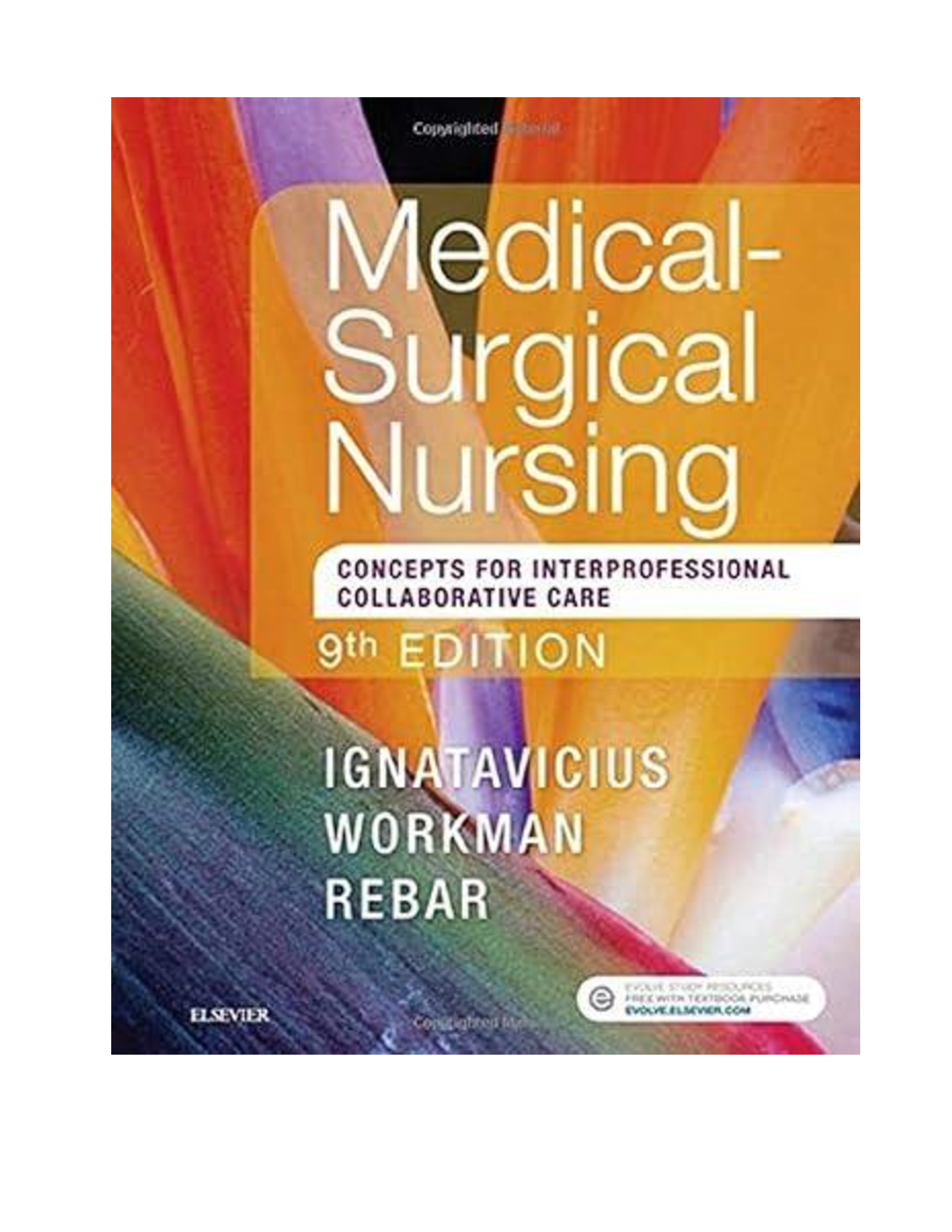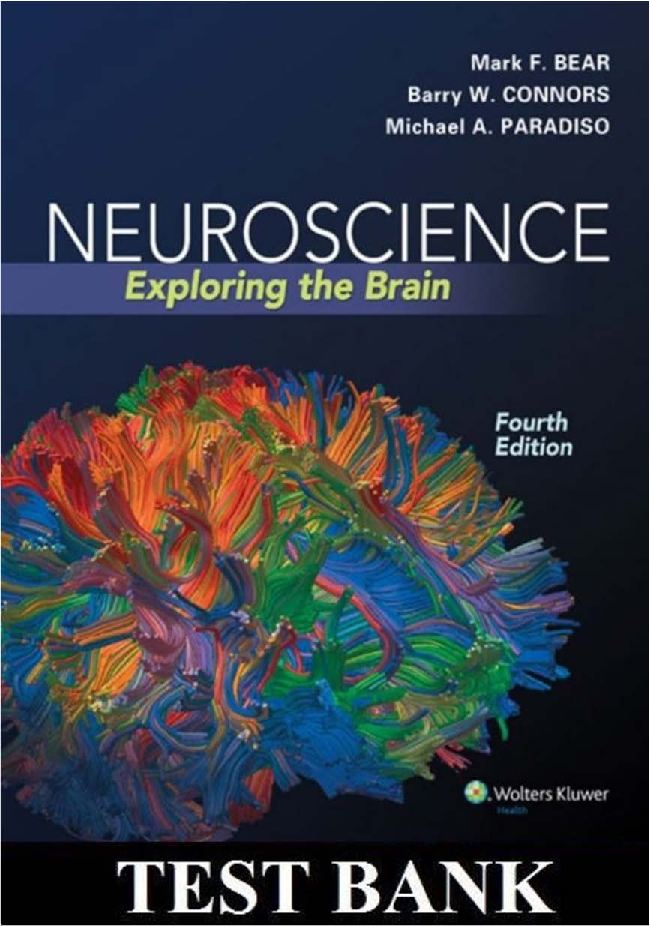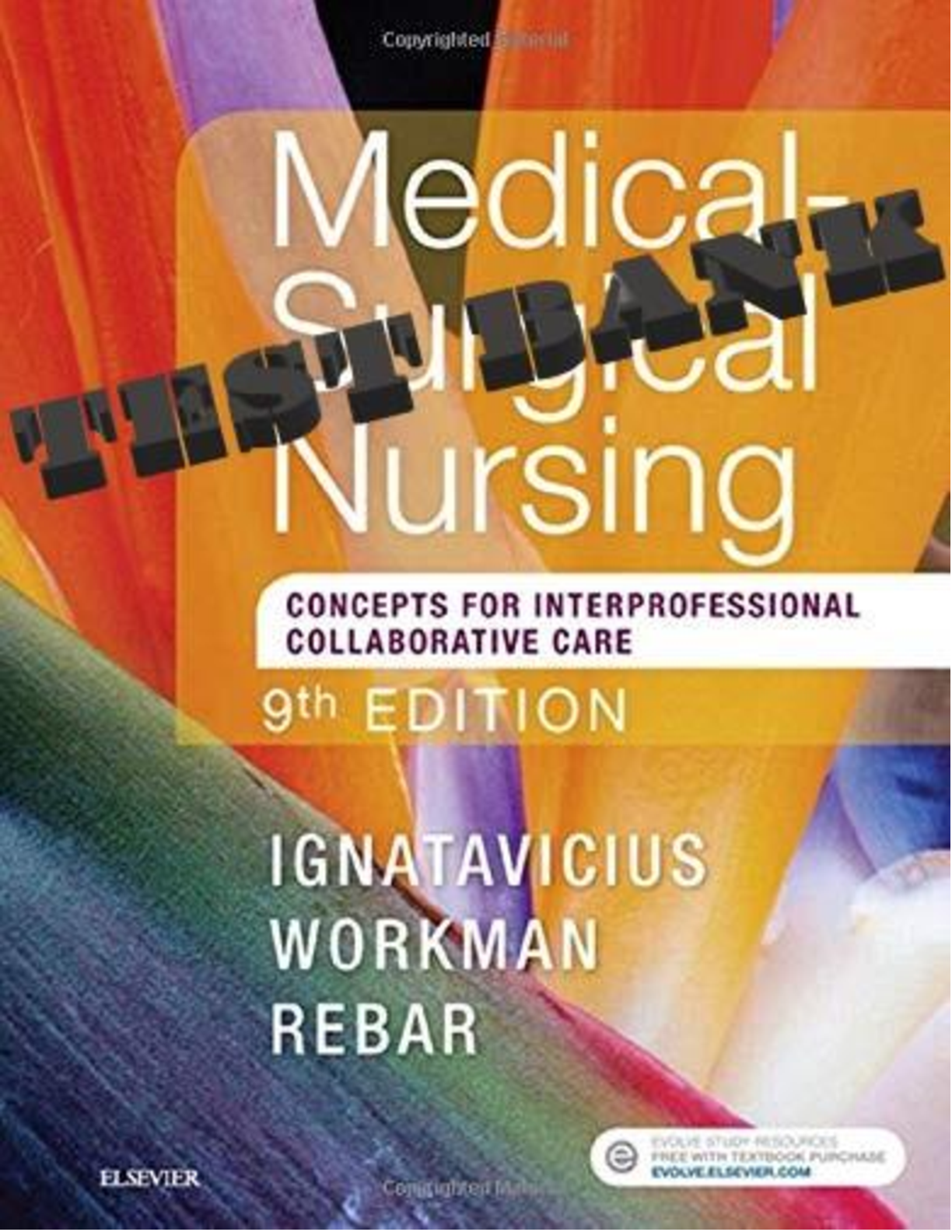*NURSING > TEST BANK > Test Bank -Medical-Surgical Nursing: Concepts for Interprofessional Collaborative Care 9th edition ( (All)
Test Bank -Medical-Surgical Nursing: Concepts for Interprofessional Collaborative Care 9th edition (All chapters complete 1 - 74, Question and Answers with Rationales)
Document Content and Description Below
Test Bank -Medical-Surgical Nursing: Concepts for Interprofessional Collaborative Care 9th edition (All chapters complete 1 - 74, Question and Answers with Rationales) Test Bank -Medical-Surgical Nur... sing: Concepts for Interprofessional Collaborative Care 9th edition Test Bank - Medical-Surgical Nursing: Concepts for Interprofessional Collaborative Care 9e Healthcare is evolving at an incredible pace and with it, the roles and responsibilities of the medical-surgical nurse. Ensure you are fully equipped to thrive and adapt in this ever-changing nursing environment with Ignatavicius, Workman, and Rebar's Medical-Surgical Nursing: Concepts for Interprofessional Collaborative Care, 9th Edition. This trendsetting text not only covers all essential adult health knowledge, but also reinforces the application, conceptual thinking, and clinical judgment skills that today’s nurses need to stay one step ahead in delivering exceptional patient care, no matter the environment. As with previous "Iggy" editions, you’ll find a unique collaborative care approach to adult health nursing, a thorough integration of QSEN competencies, extensive NCLEX® Exam preparation, and a direct, reader-friendly tone throughout the text. This ninth edition incorporates two emerging and complementary trends — the Core Competencies for Interprofessional Table of Contents Chapter 01: Overview of Professional Nursing Concepts for Medical-Surgical Nursing Chapter 02: Overview of Health Concepts for Medical-Surgical Nursing Chapter 03: Common Health Problems of Older Adults Chapter 04: Assessment and Care of Patients with Pain Chapter 05: Genetic Concepts for Medical-Surgical Nursing Chapter 06: Rehabilitation Concepts for Chronic and Disabling Health Problems Chapter 07: End-of-Life Care Chapter 08: Concepts of Emergency and Trauma Nursing Chapter 09: Care of Patients with Common Environmental Emergencies Chapter 10: Concepts of Emergency and Disaster Preparedness Chapter 11: Assessment and Care of Patients with Fluid and Electrolyte Imbalances Chapter 12: Assessment and Care of Patients with Acid-Base Imbalances Chapter 13: Infusion Therapy Chapter 14: Care of Preoperative Patients Chapter 15: Care of Intraoperative Patients Chapter 16: Care of Postoperative Patients Chapter 17: Inflammation and Immunity Chapter 18: Care of Patients with Arthritis and Other Connective Tissue Diseases Chapter 19: Care of Patients with HIV Disease Chapter 20: Care of Patients with Hypersensitivity (Allergy) and Autoimmunity Chapter 21: Cancer Development Chapter 22: Care of Patients with Cancer Chapter 23: Care of Patients with Infection Chapter 24: Assessment of the Skin, Hair, and Nails Chapter 25: Care of Patients with Skin Problems Chapter 26: Care of Patients with Burns Chapter 27: Assessment of the Respiratory System Chapter 28: Care of Patients Requiring Oxygen Therapy or Tracheostomy Chapter 29: Care of Patients with Noninfectious Upper Respiratory Problems Chapter 30: Care of Patients with Noninfectious Lower Respiratory Problems Chapter 31: Care of Patients with Infectious Respiratory Problems Chapter 32: Care of Critically Ill Patients with Respiratory Problems Chapter 33: Assessment of the Cardiovascular System Chapter 34: Care of Patients with Dysrhythmias Chapter 35: Care of Patients with Cardiac Problems Chapter 36: Care of Patients with Vascular Problems Chapter 37: Care of Patients with Shock Chapter 38: Care of Patients with Acute Coronary Syndromes Chapter 39: Assessment of the Hematologic System Chapter 40: Care of Patients with Hematologic Problems Chapter 41: Assessment of the Nervous System Chapter 42: Care of Patients with Problems of the CNS: The Brain Chapter 43: Care of Patients with Problems of the CNS: The Spinal Cord Chapter 44: Care of Patients with Problems of the Peripheral Nervous System Chapter 45: Care of Critically Ill Patients with Neurologic Problems Chapter 46: Assessment of the Eye and Vision Chapter 47: Care of Patients with Eye and Vision Problems Chapter 48: Assessment and Care of Patients with Ear and Hearing Problems Chapter 49: Assessment of the Musculoskeletal System Chapter 50: Care of Patients with Musculoskeletal Problems 8 Chapter 51: Care of Patients with Musculoskeletal Trauma Chapter 52: Assessment of the Gastrointestinal System Chapter 53: Care of Patients with Oral Cavity Problems Chapter 54: Care of Patients with Esophageal Problems Chapter 55: Care of Patients with Stomach Disorders Chapter 56: Care of Patients with Noninflammatory Intestinal Disorders Chapter 57: Care of Patients with Inflammatory Intestinal Disorders Chapter 58: Care of Patients with Liver Problems Chapter 59: Care of Patients with Problems of the Biliary System and Pancreas Chapter 60: Care of Patients with Malnutrition: Undernutrition and Obesity Chapter 61: Assessment of the Endocrine System Chapter 62: Care of Patients with Pituitary and Adrenal Gland Problems Chapter 63: Care of Patients with Problems of the Thyroid and Parathyroid Glands Chapter 64: Care of Patients with Diabetes Mellitus Chapter 65: Assessment of the Renal/Urinary System Chapter 66: Care of Patients with Urinary Problems Chapter 67: Care of Patients with Kidney Disorders Chapter 68: Care of Patients with Acute Kidney Injury and Chronic Kidney Disease Chapter 69: Assessment of the Reproductive System Chapter 70: Care of Patients with Breast Disorders Chapter 71: Care of Patients with Gynecologic Problems Chapter 72: Care of Patients with Male Reproductive Problems Chapter 73: Care of Transgender Patients Chapter 74: Care of Patients with Sexually Transmitted Diseases Chapter 01: Overview of Professional Nursing Concepts for Medical- Surgical Nursing MULTIPLE CHOICE 1. A nurse wishes to provide client-centered care in all interactions. Which action by the nurse best demonstrates this concept? a. Assesses for cultural influences affecting health care b. Ensures that all the clients basic needs are met c. Tells the client and family about all upcoming tests d. Thoroughly orients the client and family to the room ANS: A Competency in client-focused care is demonstrated when the nurse focuses on communication, culture, respect, compassion, client education, and empowerment. By assessing the effect of the clients culture on health care, this nurse is practicing client-focused care. Providing for basic needs does not demonstrate this competence. Simply telling the client about all upcoming tests is not providing empowering education. Orienting the client and family to the room is an important safety measure, but not directly related to demonstrating client-centered care. DIF: Understanding/Comprehension REF: 3 KEY: Patient-centered care| culture MSC: Integrated Process: Caring NOT: Client Needs Category: Psychosocial Integrity 2. A nurse is caring for a postoperative client on the surgical unit. The clients blood pressure was 142/76 mm Hg 30 minutes ago, and now is 88/50 mm Hg. What action by the nurse is best? a. Call the Rapid Response Team. b. Document and continue to monitor. c. Notify the primary care provider. d. Repeat blood pressure measurement in 15 minutes. ANS: A The purpose of the Rapid Response Team (RRT) is to intervene when clients are deteriorating before they suffer either respiratory or cardiac arrest. Since the client has manifested a significant change, the nurse should call the RRT. Changes in blood pressure, mental status, heart rate, and pain are particularly significant. Documentation is vital, but the nurse must do more than document. The primary care provider should be notified, but this is not the priority over calling the RRT. The clients blood pressure should be reassessed frequently, but the priority is getting the rapid care to the client. DIF: Applying/Application REF: 3 KEY: Rapid Response Team (RRT)| medical emergencies MSC: Integrated Process: Communication and Documentation NOT: Client Needs Category: Physiological Integrity: Physiological Adaptation 3. A nurse is orienting a new client and family to the inpatient unit. What information does the nurse provide to help the client promote his or her own safety? a. Encourage the client and family to be active partners. b. Have the client monitor hand hygiene in caregivers. c. Offer the family the opportunity to stay with the client. d. Tell the client to always wear his or her armband. ANS: A Each action could be important for the client or family to perform. However, encouraging the client to be active in his or her health care as a partner is the most critical. The other actions are very limited in scope and do not provide the broad protection that being active and involved does. DIF: Understanding/Comprehension REF: 3 KEY: Patient safety Test Bank - Medical-Surgical Nursing: Concepts for Interprofessional Collaborative Care 9e 3 MSC: Integrated Process: Teaching/Learning NOT: Client Needs Category: Safe and Effective Care Environment: Safety and Infection Control 4. A new nurse is working with a preceptor on an inpatient medical-surgical unit. The preceptor advises the student that which is the priority when working as a professional nurse? a. Attending to holistic client needs b. Ensuring client safety c. Not making medication errors d. Providing client-focused care ANS: B All actions are appropriate for the professional nurse. However, ensuring client safety is the priority. Up to 98,000 deaths result each year from errors in hospital care, according to the 2000 Institute of Medicine report. Many more clients have suffered injuries and less serious outcomes. Every nurse has the responsibility to guard the clients safety. DIF: Understanding/Comprehension REF: 2 KEY: Patient safety MSC: Integrated Process: Nursing Process: Intervention NOT: Client Needs Category: Safe and Effective Care Environment: Safety and Infection Control 5. A client is going to be admitted for a scheduled surgical procedure. Which action does the nurse explain is the most important thing the client can do to protect against errors? a. Bring a list of all medications and what they are for. b. Keep the doctors phone number by the telephone. c. Make sure all providers wash hands before entering the room. d. Write down the name of each caregiver who comes in the room. ANS: A Medication errors are the most common type of health care mistake. The Joint Commissions Speak Up campaign encourages clients to help ensure their safety. One recommendation is for clients to know all their medications and why they take them. This will help prevent medication errors. DIF: Applying/Application REF: 4 KEY: Speak Up campaign| patient safety MSC: Integrated Process: Teaching/Learning NOT: Client Needs Category: Safe and Effective Care Environment: Safety and Infection Control 6. Which action by the nurse working with a client best demonstrates respect for autonomy? a. Asks if the client has questions before signing a consent b. Gives the client accurate information when questioned c. Keeps the promises made to the client and family d. Treats the client fairly compared to other clients ANS: A Autonomy is self-determination. The client should make decisions regarding care. When the nurse obtains a signature on the consent form, assessing if the client still has questions is vital, because without full information the client cannot practice autonomy. Giving accurate information is practicing with veracity. Keeping promises is upholding fidelity. Treating the client fairly is providing social justice. DIF: Applying/Application REF: 4 KEY: Autonomy| ethical principles MSC: Integrated Process: Caring NOT: Client Needs Category: Safe and Effective Care Environment: Management of Care 7. A student nurse asks the faculty to explain best practices when communicating with a person from the lesbian, gay, bisexual, transgender, and queer/questioning (LGBTQ) community. What answer by the faculty is most accurate? a. Avoid embarrassing the client by asking questions. b. Dont make assumptions about their health needs. c. Most LGBTQ people do not want to share information. Test Bank - Medical-Surgical Nursing: Concepts for Interprofessional Collaborative Care 9e 4 d. No differences exist in communicating with this population. ANS: B Many members of the LGBTQ community have faced discrimination from health care providers and may be reluctant to seek health care. The nurse should never make assumptions about the needs of members of this population. Rather, respectful questions are appropriate. If approached with sensitivity, the client with any health care need is more likely to answer honestly. DIF: Understanding/Comprehension REF: 4 KEY: LGBTQ| diversity MSC: Integrated Process: Teaching/Learning NOT: Client Needs Category: Psychosocial Integrity 8. A nurse is calling the on-call physician about a client who had a hysterectomy 2 days ago and has pain that is unrelieved by the prescribed narcotic pain medication. Which statement is part of the SBAR format for communication? a. A: I would like you to order a different pain medication. b. B: This client has allergies to morphine and codeine. c. R: Dr. Smith doesnt like nonsteroidal anti-inflammatory meds. d. S: This client had a vaginal hysterectomy 2 days ago. ANS: B SBAR is a recommended form of communication, and the acronym stands for Situation, Background, Assessment, and Recommendation. Appropriate background information includes allergies to medications the on-call physician might order. Situation describes what is happening right now that must be communicated; the clients surgery 2 days ago would be considered background. Assessment would include an analysis of the clients problem; asking for a different pain medication is a recommendation. Recommendation is a statement of what is needed or what outcome is desired; this information about the surgeons preference might be better placed in background. DIF: Applying/Application REF: 5 KEY: SBAR| communication MSC: Integrated Process: Communication and Documentation NOT: Client Needs Category: Safe and Effective Care Environment: Management of Care 9. A nurse working on a cardiac unit delegated taking vital signs to an experienced unlicensed assistive personnel (UAP). Four hours later, the nurse notes the clients blood pressure is much higher than previous readings, and the clients mental status has changed. What action by the nurse would most likely have prevented this negative outcome? a. Determining if the UAP knew how to take blood pressure b. Double-checking the UAP by taking another blood pressure c. Providing more appropriate supervision of the UAP d. Taking the blood pressure instead of delegating the task ANS: C Supervision is one of the five rights of delegation and includes directing, evaluating, and following up on delegated tasks. The nurse should either have asked the UAP about the vital signs or instructed the UAP to report them right away. An experienced UAP should know how to take vital signs and the nurse should not have to assess this at this point. Double-checking the work defeats the purpose of delegation. Vital signs are within the scope of practice for a UAP and are permissible to delegate. The only appropriate answer is that the nurse did not provide adequate instruction to the UAP. DIF: Applying/Application REF: 6 KEY: Supervision| delegation| unlicensed assistive personnel MSC: Integrated Process: Communication and Documentation NOT: Client Needs Category: Safe and Effective Care Environment: Management of Care 10. A nurse is talking with a client who is moving to a new state and needs to find a new doctor and hospital there. What advice by the nurse is best? Test Bank - Medical-Surgical Nursing: Concepts for Interprofessional Collaborative Care 9e 5 a. Ask the hospitals there about standard nurse-client ratios. b. Choose the hospital that has the newest technology. c. Find a hospital that is accredited by The Joint Commission. d. Use a facility affiliated with a medical or nursing school. ANS: C Accreditation by The Joint Commission (TJC) or other accrediting body gives assurance that the facility has a focus on safety. Nurse-client ratios differ by unit type and change over time. New technology doesnt necessarily mean the hospital is safe. Affiliation with a health professions school has several advantages, but safety is most important. DIF: Understanding/Comprehension REF: 2 KEY: The Joint Commission (TJC)| accreditation MSC: Integrated Process: Communication and Documentation NOT: Client Needs Category: Safe and Effective Care Environment: Safety and Infection Control 11. A newly graduated nurse in the hospital states that, since she is so new, she cannot participate in quality improvement (QI) projects. What response by the precepting nurse is best? a. All staff nurses are required to participate in quality improvement here. b. Even being new, you can implement activities designed to improve care. c. Its easy to identify what indicators should be used to measure quality. d. You should ask to be assigned to the research and quality committee. ANS: B The preceptor should try to reassure the nurse that implementing QI measures is not out of line for a newly licensed nurse. Simply stating that all nurses are required to participate does not help the nurse understand how that is possible and is dismissive. Identifying indicators of quality is not an easy, quick process and would not be the best place to suggest a new nurse to start. Asking to be assigned to the QI committee does not give the nurse information about how to implement QI in daily practice. DIF: Applying/Application REF: 6 KEY: Quality improvement MSC: Integrated Process: Communication and Documentation NOT: Client Needs Category: Safe and Effective Care Environment: Management of Care MULTIPLE RESPONSE 1. A nurse is interested in making interdisciplinary work a high priority. Which actions by the nurse best demonstrate this skill? (Select all that apply.) a. Consults with other disciplines on client care b. Coordinates discharge planning for home safety c. Participates in comprehensive client rounding d. Routinely asks other disciplines about client progress e. Shows the nursing care plans to other disciplines ANS: A, B, C, D Collaborating with the interdisciplinary team involves planning, implementing, and evaluating client care as a team with all other disciplines included. Simply showing other caregivers the nursing care plan is not actively involving them or collaborating with them. DIF: Applying/Application REF: 4 KEY: Collaboration| interdisciplinary team MSC: Integrated Process: Communication and Documentation NOT: Client Needs Category: Safe and Effective Care Environment: Management of Care 2. A nurse manager wishes to ensure that the nurses on the unit are practicing at their highest levels of competency. Which areas should the manager assess to determine if the nursing staff demonstrate competency according to the Institute of Medicine (IOM) report Health Professions Education: A Bridge to Quality? (Select all that apply.) Test Bank - Medical-Surgical Nursing: Concepts for Interprofessional Collaborative Care 9e 6 a. Collaborating with an interdisciplinary team b. Implementing evidence-based care c. Providing family-focused care d. Routinely using informatics in practice e. Using quality improvement in client care ANS: A, B, D, E The IOM report lists five broad core competencies that all health care providers should practice. These include collaborating with the interdisciplinary team, implementing evidence-based practice, providing client-focused care, using informatics in client care, and using quality improvement in client care. DIF: Remembering/Knowledge REF: 3 KEY: Competencies| Institute of Medicine (IOM) MSC: Integrated Process: Nursing Process: Assessment NOT: Client Needs Category: Safe and Effective Care Environment: Safety and Infection Control 3. The nurse utilizing evidence-based practice (EBP) considers which factors when planning care? (Select all that apply.) a. Cost-saving measures b. Nurses expertise c. Client preferences d. Research findings e. Values of the client ANS: B, C, D, E EBP consists of utilizing current evidence, the clients values and preferences, and the nurses expertise when planning care. It does not include cost-saving measures. DIF: Remembering/Knowledge REF: 6 KEY: Evidence-based practice (EBP) MSC: Integrated Process: Nursing Process: Planning NOT: Client Needs Category: Safe and Effective Care Environment: Management of Care 4. A nurse manager wants to improve hand-off communication among the staff. What actions by the manager would best help achieve this goal? (Select all that apply.) a. Attend hand-off rounds to coach and mentor. b. Conduct audits of staff using a new template. c. Create a template of topics to include in report. d. Encourage staff to ask questions during hand-off. e. Give raises based on compliance with reporting. ANS: A, B, C, D A good tool for standardizing hand-off reports and other critical communication is the SHARE model. SHARE stands for standardize critical information, hardwire within your system, allow opportunities to ask questions, reinforce quality and measurement, and educate and coach. Attending hand-off report gives the manager opportunities to educate and coach. Conducting audits is part of reinforcing quality. Creating a template is hardwiring within the system. Encouraging staff to ask questions and think critically about the information is allowing opportunities to ask questions. The manager may need to tie raises into compliance if the staff is resistive and other measures have failed, but this is not part of the SHARE model. DIF: Applying/Application REF: 5 KEY: SHARE| hand-off communication MSC: Integrated Process: Nursing Process: Intervention NOT: Client Needs Category: Safe and Effective Care Environment: Management of Care Test Bank - Medical-Surgical Nursing: Concepts for Interprofessional Collaborative Care 9e 7 Chapter 02: Overview of Health Concepts for Medical-Surgical Nursing MULTIPLE CHOICE 1. Acid-base balance occurs when the pH level of the blood is between: a. 7.3 and 7.5 b. 7.35 and 7.45 c. 7.4 and 7.5 d. 7.25 and 7.35 ANS: B Acid-base balance is the maintenance of arterial blood pH between 7.35 and 7.45 through hydrogen ion production and elimination. DIF: Understanding/Comprehension REF: 13 KEY: Assessment MSC: Physiological Adaptation | Fluid and Electrolyte Imbalances NOT: Describe common fluid, electrolyte, and acid-base imbalances. 2. The nurse would expect a patient with respiratory acidosis to have an excessive amount of a. Hydrogen ions. b. Bicarbonate. c. Oxygen. d. Phosphate. ANS: A Respiratory acidosis occurs when the arterial blood pH level falls below 7.35 and is caused by either too many hydrogen ions in the body (respiratory acidosis) or too little bicarbonate (metabolic acidosis). Excessive oxygen and phosphate are not characteristic of respiratory acidosis. DIF: Understanding/Comprehension REF: 13 KEY: Assessment MSC: Physiological Adaptation | Fluid and Electrolyte Imbalances NOT: Describe common fluid, electrolyte, and acid-base imbalances. 3. The best way for an individual to maintain acid-base balance is to a. avoid or quit smoking. b. exercise regularly. c. eat healthy and well-balanced meals. d. All of the above. ANS: D Maintaining a healthy lifestyle is the best way to maintain acid-base balance. For example, most cases of COPD can be prevented by avoiding or quitting smoking, while regular exercise and a healthy diet can decrease the incidence of type-2 diabetes. DIF: Patient education REF: 14 KEY: Assessment MSC: Integrated Process: Teaching/Learning NOT: Client Needs Category: Health Promotion and Maintenance 4. The process to control cellular growth, replication, and differentiation to maintain homeostasis is called: a. cellular regulation. b. cellular impairment. c. cellular reproduction. d. cellular tumor. ANS: A Cellular Regulation is the term used to describe both the positive and negative aspects of cellular function Test Bank - Medical-Surgical Nursing: Concepts for Interprofessional Collaborative Care 9e 8 within the body. DIF: Understanding/Comprehension REF: 14 KEY: Assessment MSC: Integrated Process: Teaching/Learning NOT: Client Needs Category: Health Promotion and Maintenance 5. A defining characteristic of malignant (cancerous) cells is: a. they cannot spread to other tissues or organs. b. they can invade healthy cells, tissues, and organs. c. they are not usually a health risk. d. none of the above. ANS: B Malignant (cancerous) cells have no comparison to the original cells from which they are derived, and they have the ability to invade healthy cells, tissues, and other organs through tumor formation and invasion. On the other hand, Benign cells do not have the ability to spread to other tissues or organs. DIF: Understanding/Comprehension REF: 14 KEY: Assessment MSC: Integrated Process: Teaching/Learning NOT: Client Needs Category: Health Promotion and Maintenance 6. Specialized cells that circulate in the body to promote clotting are called: a. anticoagulants. b. proteins. c. emboli. d. platelets. ANS: D Clotting is a complex, multi-step process through which blood forms a protein-based clot to prevent excessive bleeding. Platelets (thrombocytes) are the specialized cells that circulate in the blood and are activated when an injury occurs. Once activated, these cells become sticky, causing them to clump together to form a temporary, localized, solid plug. DIF: Understanding/Comprehension REF: 15 KEY: Assessment MSC: Integrated Process: Teaching/Learning NOT: Client Needs Category: Health Promotion and Maintenance 7. An increase in platelet stickiness can lead to: a. hypercoagulability b. thromobocytopenia c. embolus d. atrial fibrillation ANS: A Hypercoagulability refers to an increase in clotting ability caused by an excess of platelets or excessive plately stickiness, which can impair blood flow. The opposite end of the spectrum involves an inability to form adequate clots, which often occurs when there is an inadequate number of circulating platelets or a reduction in platelet stickiness. DIF: Understanding/Comprehension REF: 15 KEY: Assessment MSC: Integrated Process: Teaching/Learning NOT: Client Needs Category: Health Promotion and Maintenance 8. Signs and symptoms of ________ thromobsis include localized redness, swelling, and warmth: a. arterial Test Bank - Medical-Surgical Nursing: Concepts for Interprofessional Collaborative Care 9e 9 b. venous c. partial d. atrial ANS: B Venous thrombosis is a clot formation in either superficial or deep veins, usually in the leg, and can be observed locally. DIF: Understanding/Comprehension REF: 16 KEY: Assessment MSC: Integrated Process: Teaching/Learning NOT: Client Needs Category: Health Promotion and Maintenance 9. A serious condition which is not locally observable and is typically manifested by decreased blood flow to a distal extremity is known as __________ thrombosis. a. arterial b. venous c. partial d. atrial ANS: A Arterial thrombosis is manifested by decreased blood flow (perfusion) to a distal extremity or internal organ. For example, the distal leg can become pale and cool in the case of a femoral arterial clot due to blockage of blood to the leg. This is an emergent condition and requires immediate intervention. DIF: Understanding/Comprehension REF: 16 KEY: Assessment MSC: Integrated Process: Teaching/Learning NOT: Client Needs Category: Health Promotion and Maintenance 10. A high-level thinking process that allows an individual to make decisions and judgments is known as: a. amnesia b. personality c. reasoning d. memory ANS: C Reasoning is the high-level cognitive thinking process that helps individuals make decisions and judgments. Personality is the way an individual feels and behaves, while Memory is the ability of an individual to retain and recall information. Amnesia refers to a loss of memory caused by brain trauma, congenital disorders, or acute health problems. DIF: Understanding/Comprehension REF: 16 KEY: Assessment MSC: Integrated Process: Teaching/Learning NOT: Client Needs Category: Psychosocial Integrity 11. A form of inadequate cognition in older adults which is manifested by an acute, fluctuating confusional state is known as: a. dementia b. delerium c. amnesia d. depression ANS: B Delerium is the form of acute, fluctuating confusion which lasts from a few hours to less than 1 month and that may be treatable. Dementia is a chronic state of confusion that may last from a few months to many years and that may not be reversible. Amnesia refers to a loss of memory caused by brain trauma, congenital disorders, or acute health problems. Test Bank - Medical-Surgical Nursing: Concepts for Interprofessional Collaborative Care 9e 10 DIF: Understanding/Comprehension REF: 16 KEY: Assessment MSC: Integrated Process: Teaching/Learning NOT: Client Needs Category: Psychosocial Integrity 12. The most common causes of decreased comfort for a patient are pain and ____________. a. light-headedness b. nausea c. emotional stress d. depression ANS: C Pain and emotional stress are the two leading causes of discomfort for a patient. For example, patients who are having surgery are often anxious and feel stressed about the procedure. This emotional stress may negatively impact the outcome of surgery. DIF: Understanding/Comprehension REF: 17 KEY: Assessment MSC: Integrated Process: Teaching/Learning NOT: Client Needs Category: Safe and Effective Care Environment 13. The inability to pass stool is known as ____________. a. constipation b. obstipation c. diarrhea d. incontinence ANS: B Obstipation is the inability to pass stool during bowel elimination. Constipation refers to the condition where stool can be hard, dry, and difficult to pass through the rectum. Diarrhea is at the opposite end of the continuum from constipation, and occurs when stool is watery and without solid form. Elimination is the general term to describe the excretion of waste from the body by the gastrointestinal tract and by the urinary system. DIF: Understanding/Comprehension REF: 18 KEY: Assessment MSC: Integrated Process: Teaching/Learning NOT: Client Needs Category: Health Promotion and Maintenance 14. Hypokalemia can occur in patients with prolonged diarrhea and is caused by a decrease in: a. calcium b. magnesium c. sodium d. potassium ANS: D Hypokalemia occurs when there is a decrease in serum potassium. It can be a life-threatening condition because it often causes rhythm abnormalities. An excess of potassium is referred to as Hyperkalemia. DIF: Understanding/Comprehension REF: 18 KEY: Assessment MSC: Integrated Process: Teaching/Learning NOT: Client Needs Category: Health Promotion and Maintenance 15. The minimum hourly urinary output in a patient should be at least: a. 5 mL per hour b. 10 mL per hour c. 30 mL per hour d. 60 mL per hour Test Bank - Medical-Surgical Nursing: Concepts for Interprofessional Collaborative Care 9e 11 ANS: C 30 mL per hour is the minimum hourly urinary output in a normal healthy adult. A decrease in urinary output is a sign of diminished kidney activity and fluid deficit. DIF: Understanding/Comprehension REF: 20 KEY: Assessment MSC: Integrated Process: Teaching/Learning NOT: Client Needs Category: Health Promotion and Maintenance 16. The best indicator of fluid volume changes in the body is: a. skin dryness b. weight changes c. blood pressure d. pulse rate ANS: C Changes in weight are the best indicator of fluid volume changes in the body. Monitoring blood pressure, checking pulse rate and quality, and assessing skin and mucous membranes for dryness are strong secondary indicators. DIF: Understanding/Comprehension REF: 20 KEY: Assessment MSC: Integrated Process: Teaching/Learning NOT: Client Needs Category: Health Promotion and Maintenance 17. Immunity which occurs when antibodies are passed from the mother to the fetus through the placenta or through breast milk is called: a. natural passive b. artifical passive c. natural active d. artifical active ANS: A Artifical passive immunity occurs via a specific transfusion. Natural active immunity occurs when an antigen enters the body and the body creates antibodies to fight off the antigen. Artifical active immunity occurs via vaccination or immunization. DIF: Understanding/Comprehension REF: 21-22 KEY: Assessment MSC: Integrated Process: Teaching/Learning NOT: Client Needs Category: Health Promotion and Maintenance 18. A major serum protein that is below normal in patients who have inadequate nutrition is: a. Albumin b. Globulin c. Fibrinogen d. Transferrin ANS: A A serum laboratory test to measure Albumin is the most common assessment for generalized malnutrition. DIF: Understanding/Comprehension REF: 25 KEY: Assessment MSC: Integrated Process: Teaching/Learning NOT: Client Needs Category: Health Promotion and Maintenance Test Bank - Medical-Surgical Nursing: Concepts for Interprofessional Collaborative Care 9e 12 Chapter 03: Common Health Problems of Older Adults MULTIPLE CHOICE 1. A nurse working with older adults in the community plans programming to improve morale and emotional health in this population. What activity would best meet this goal? a. Exercise program to improve physical function b. Financial planning seminar series for older adults c. Social events such as dances and group dinners d. Workshop on prevention from becoming an abuse victim [Show More]
Last updated: 11 months ago
Preview 1 out of 624 pages
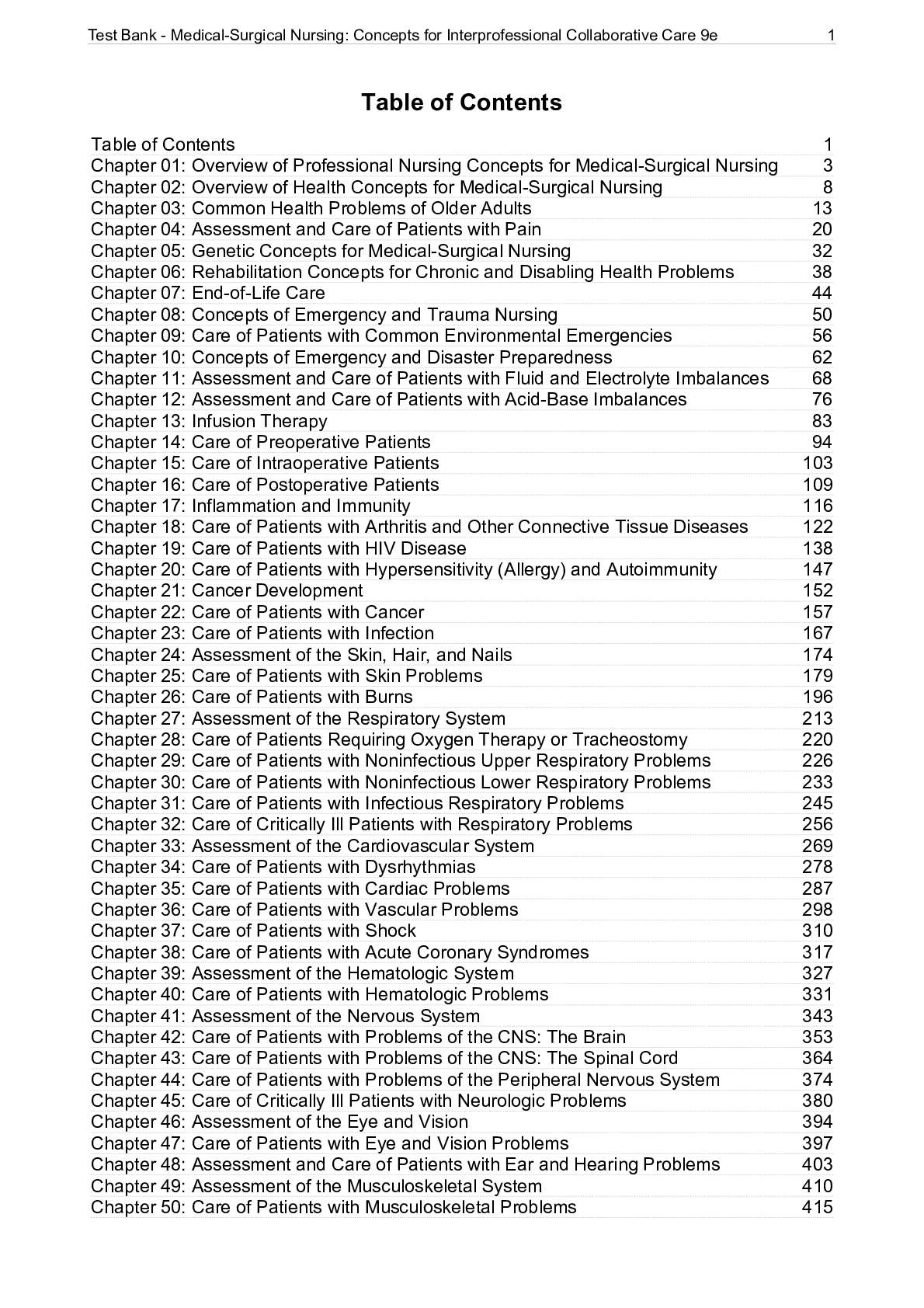
Reviews( 0 )
Document information
Connected school, study & course
About the document
Uploaded On
Sep 09, 2021
Number of pages
624
Written in
Additional information
This document has been written for:
Uploaded
Sep 09, 2021
Downloads
0
Views
49

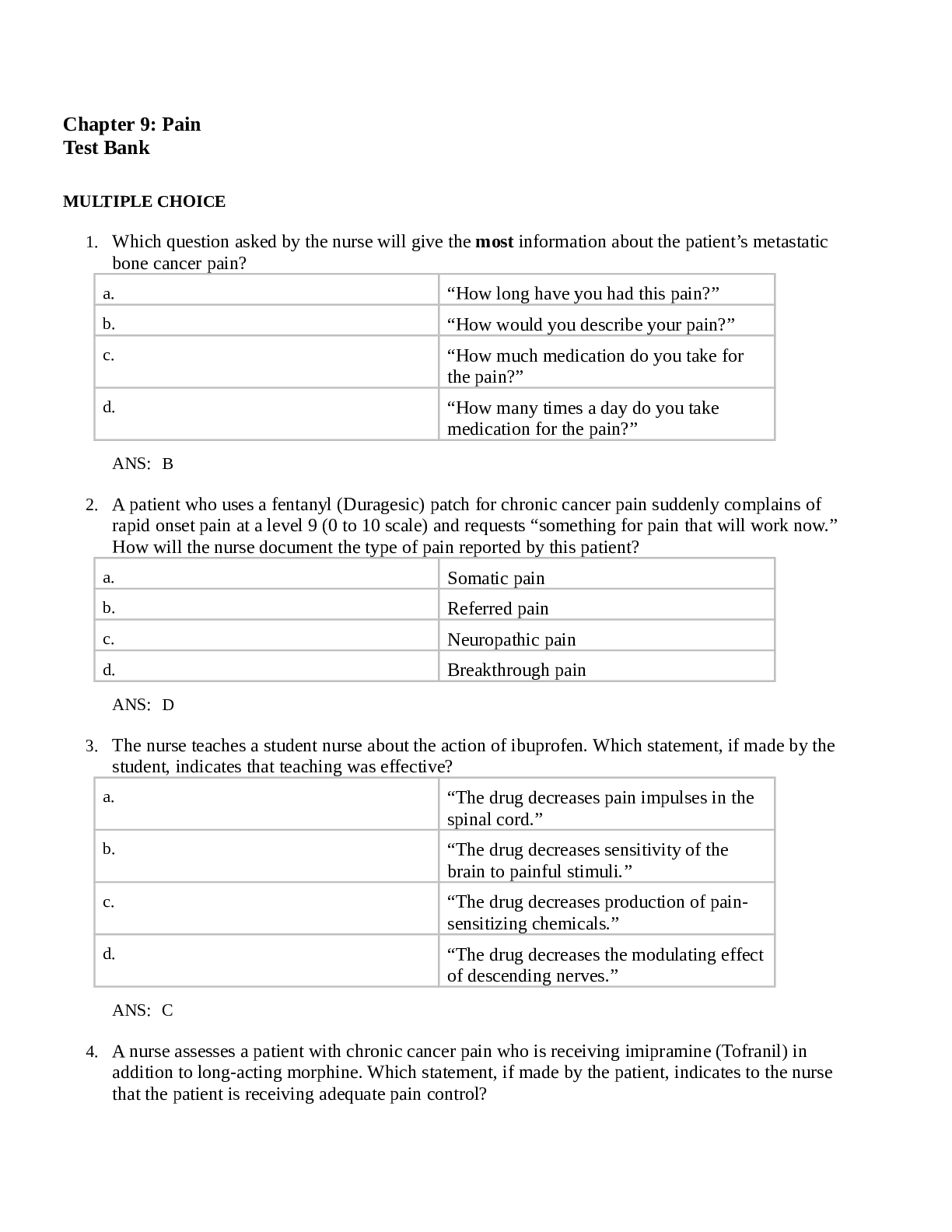
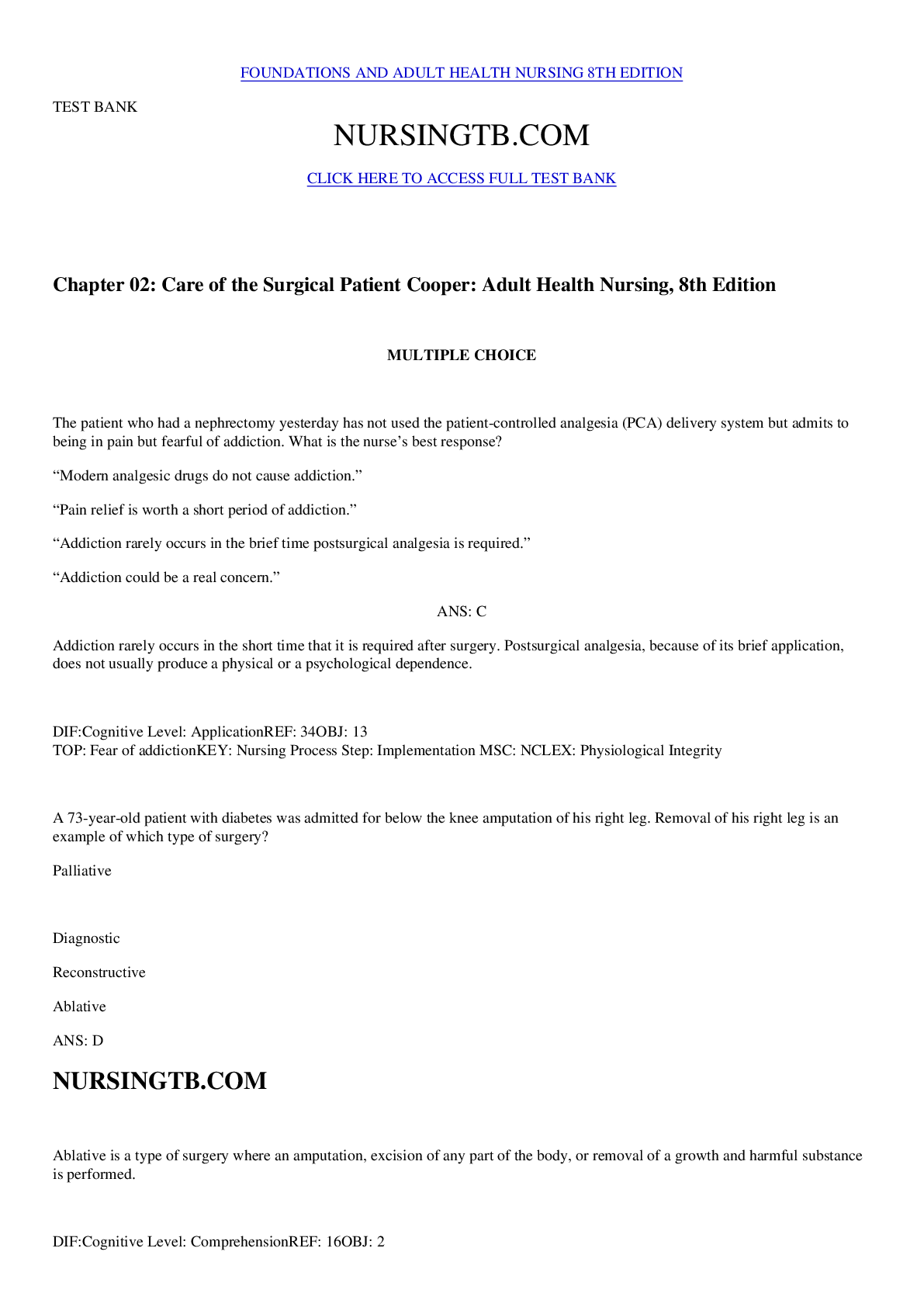
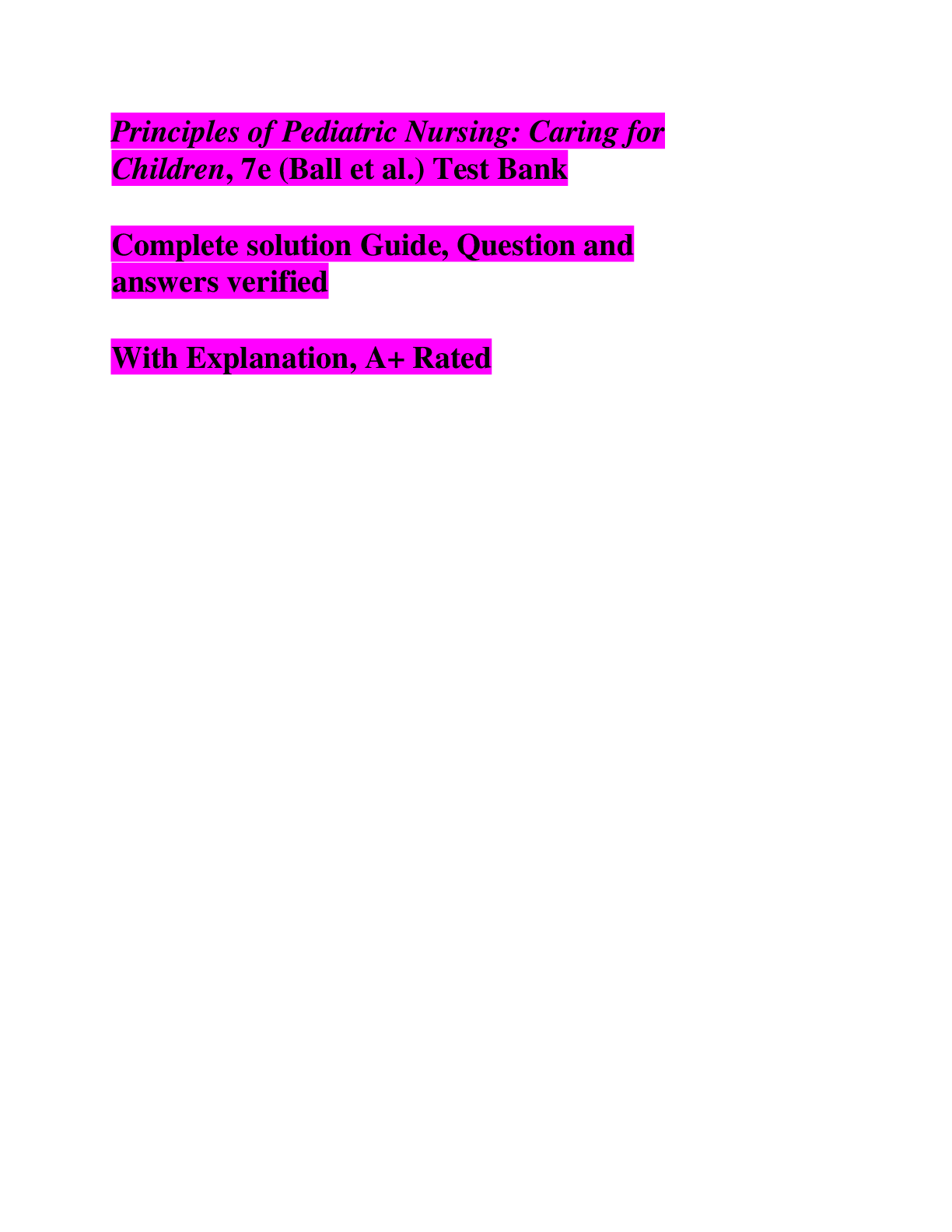
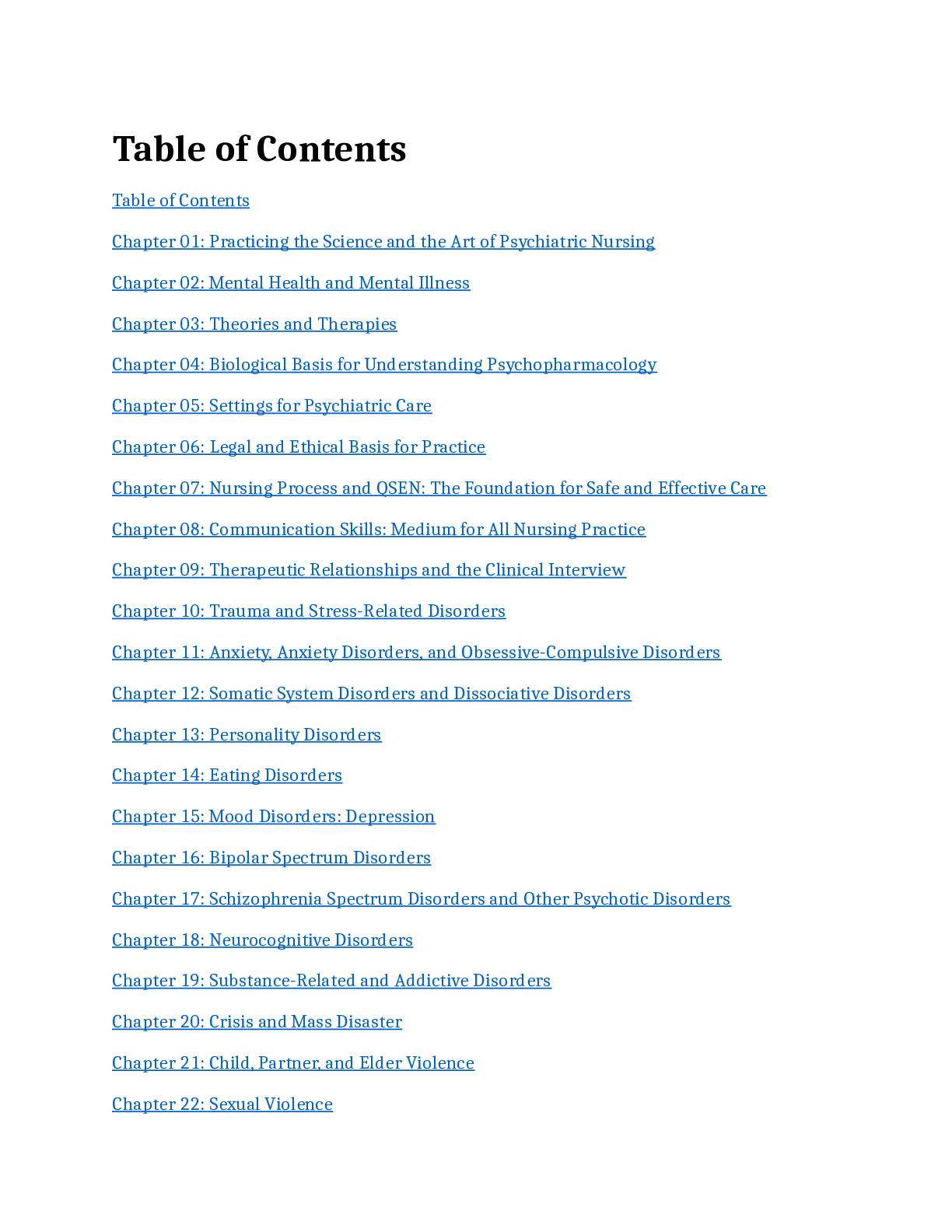
.png)


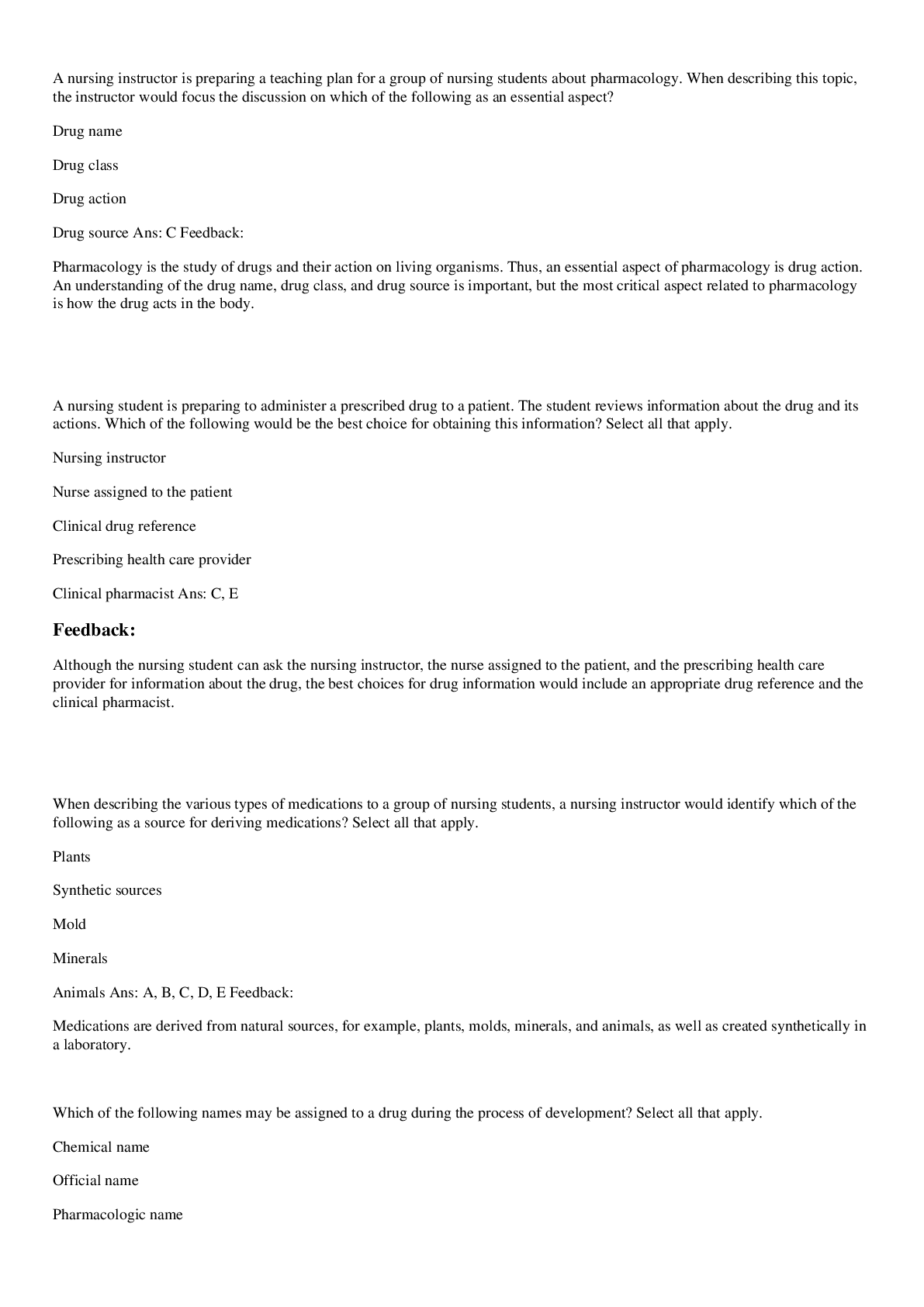
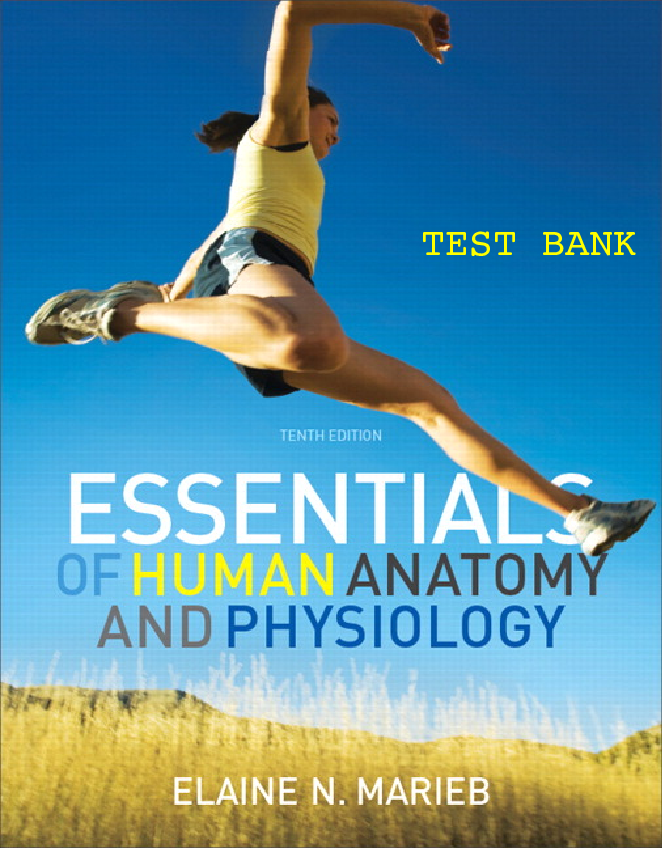
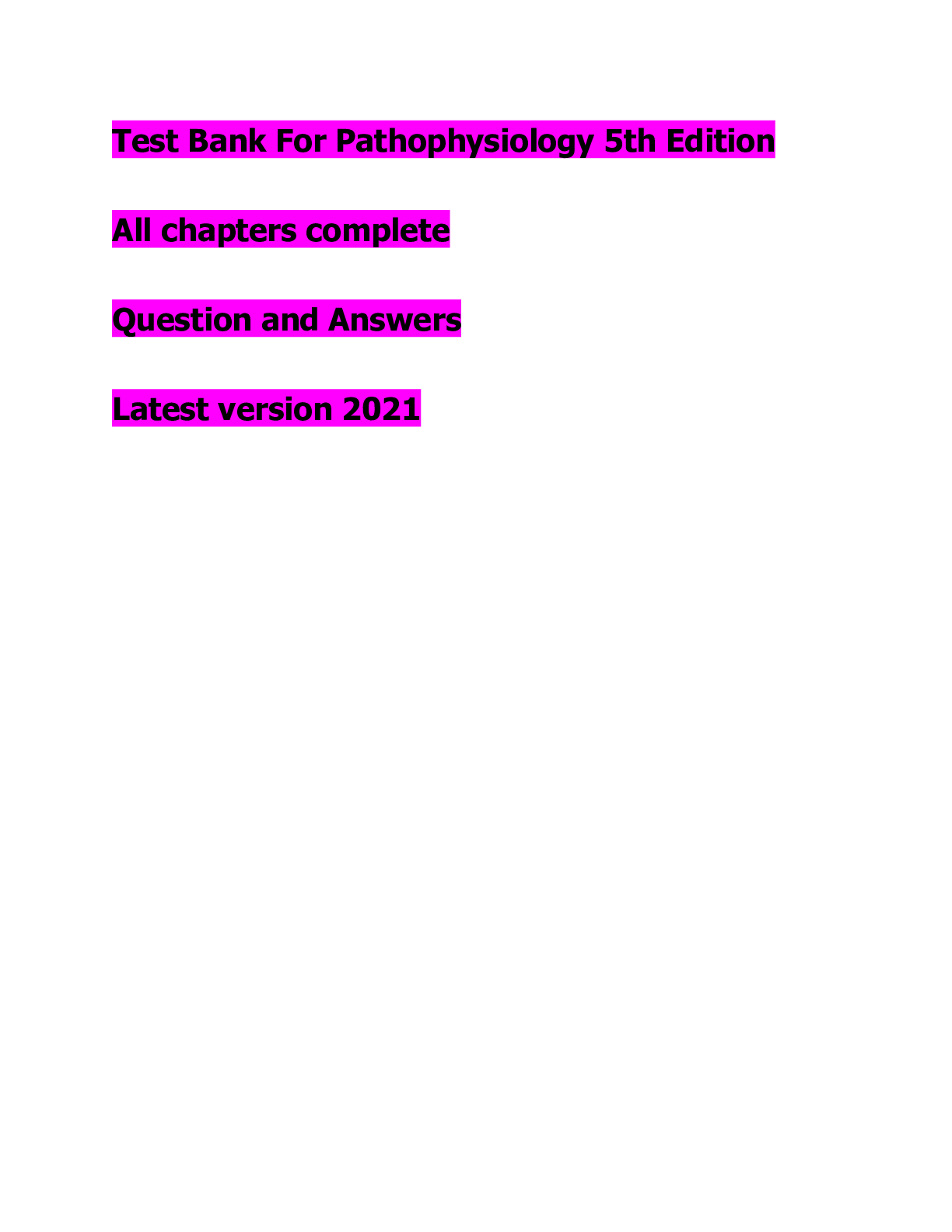

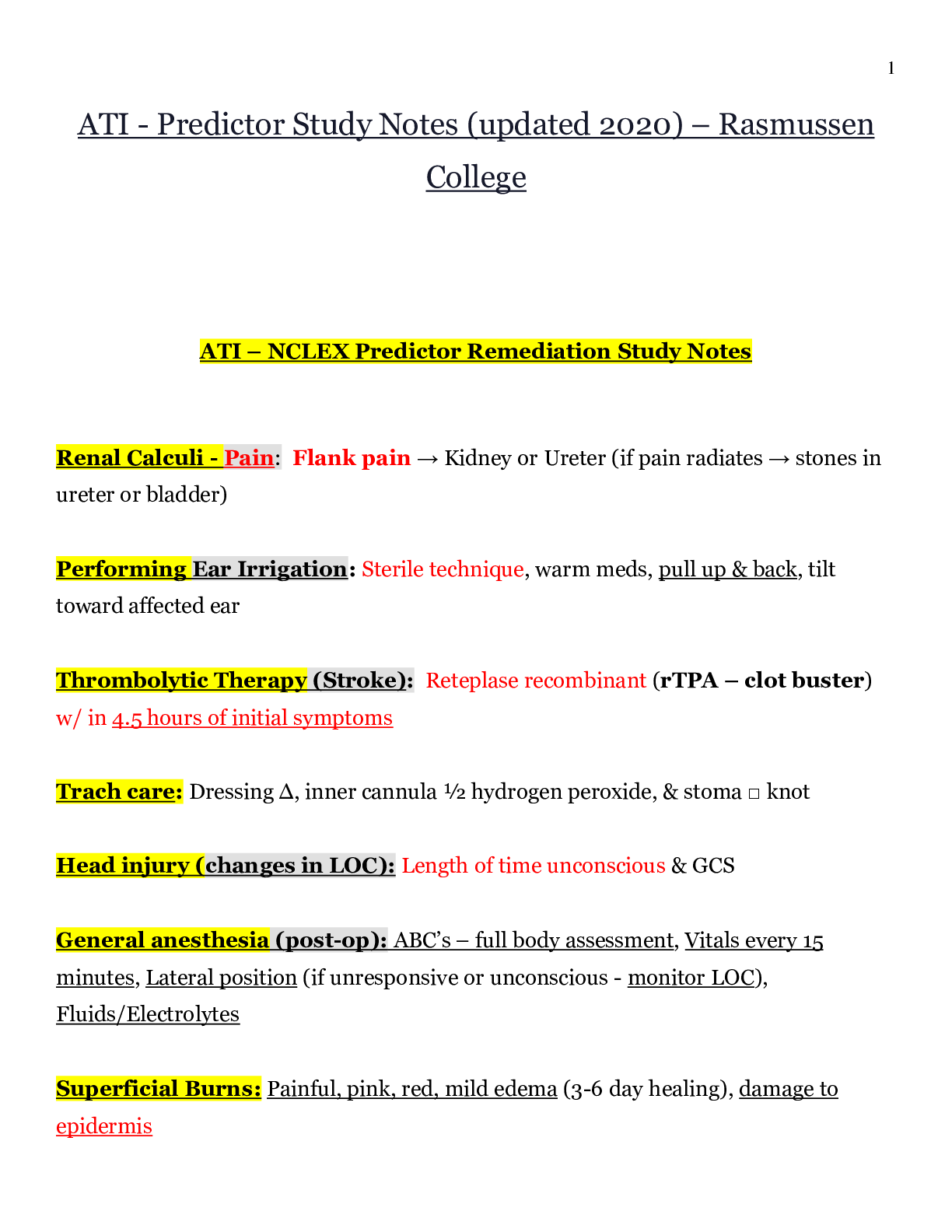
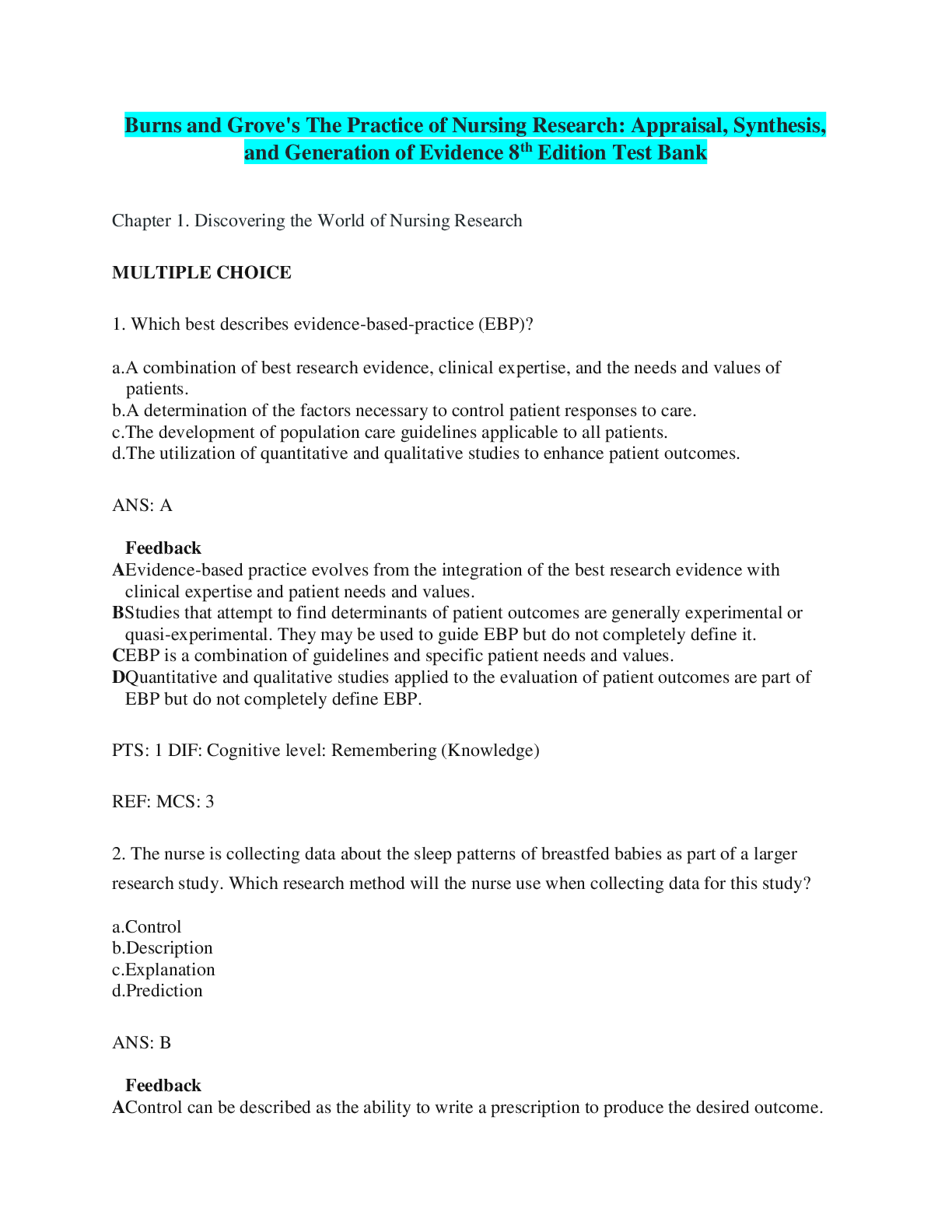
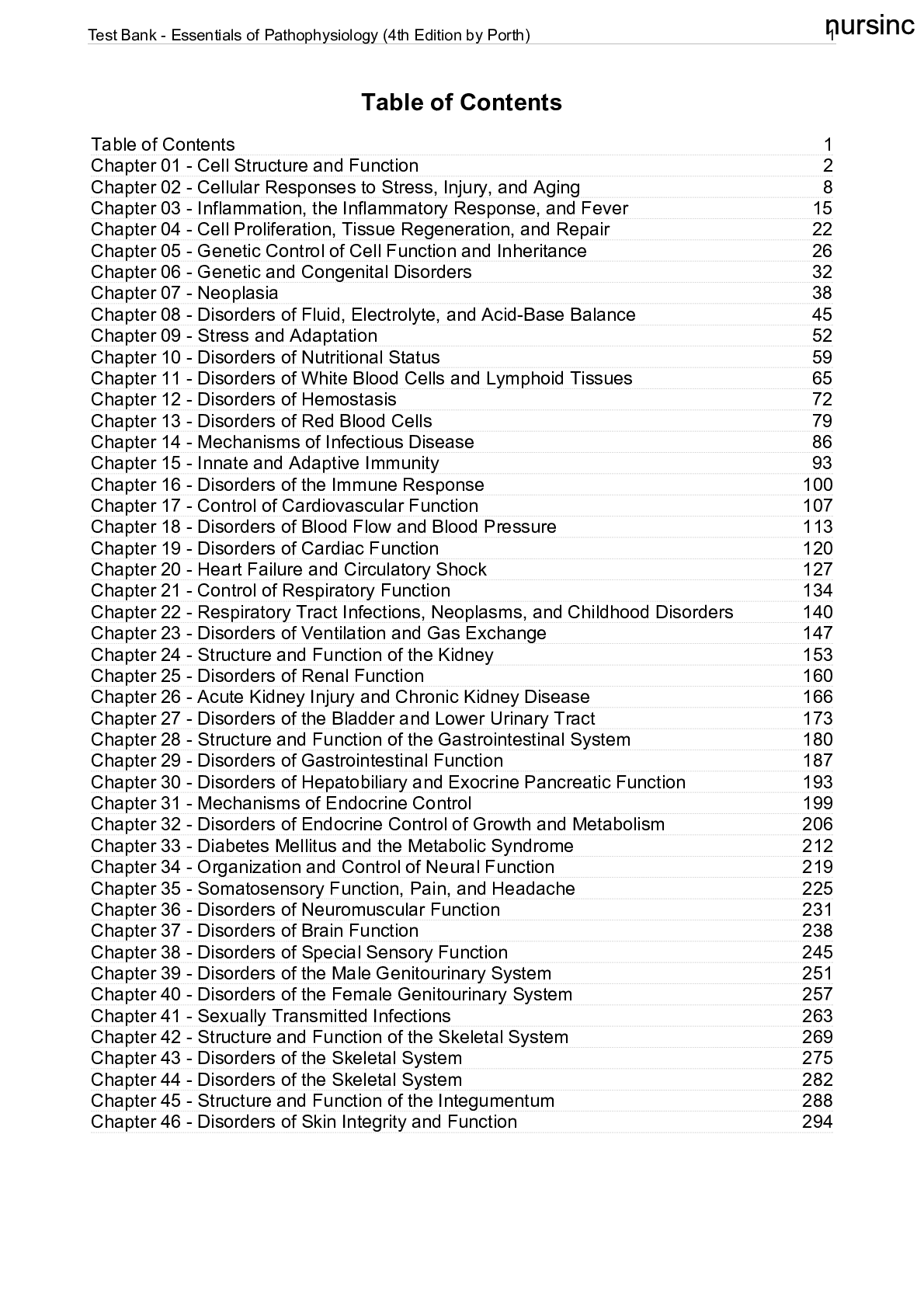
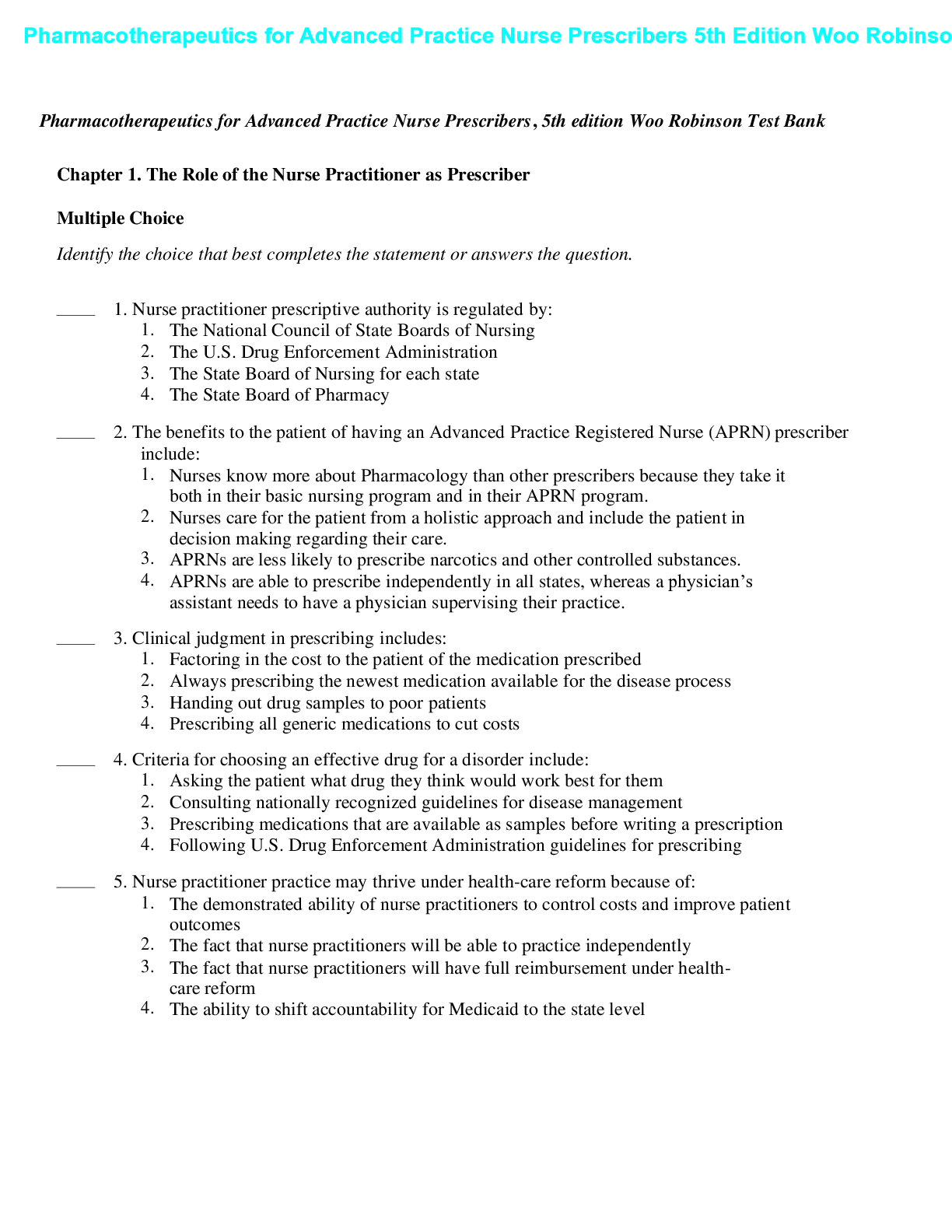

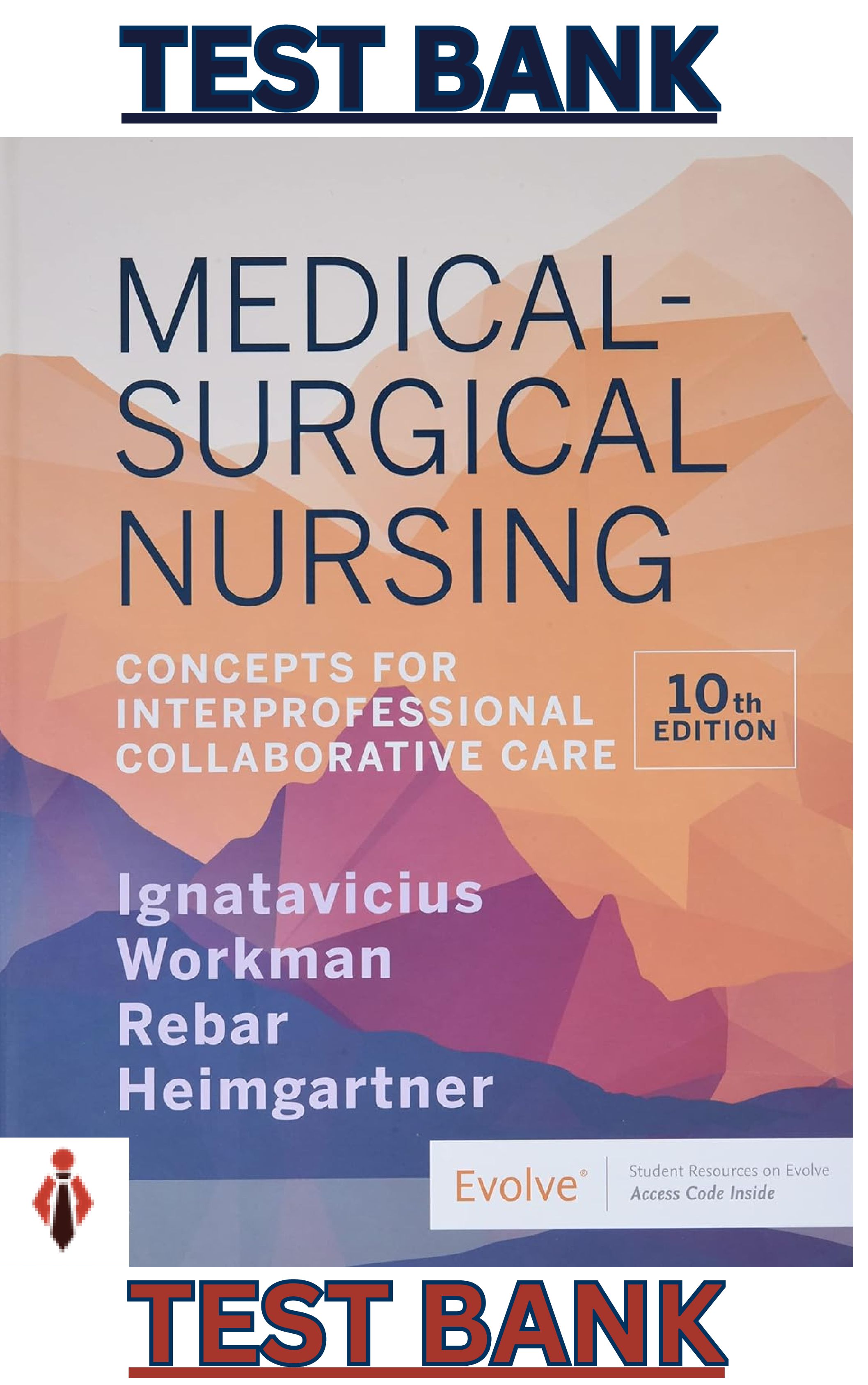
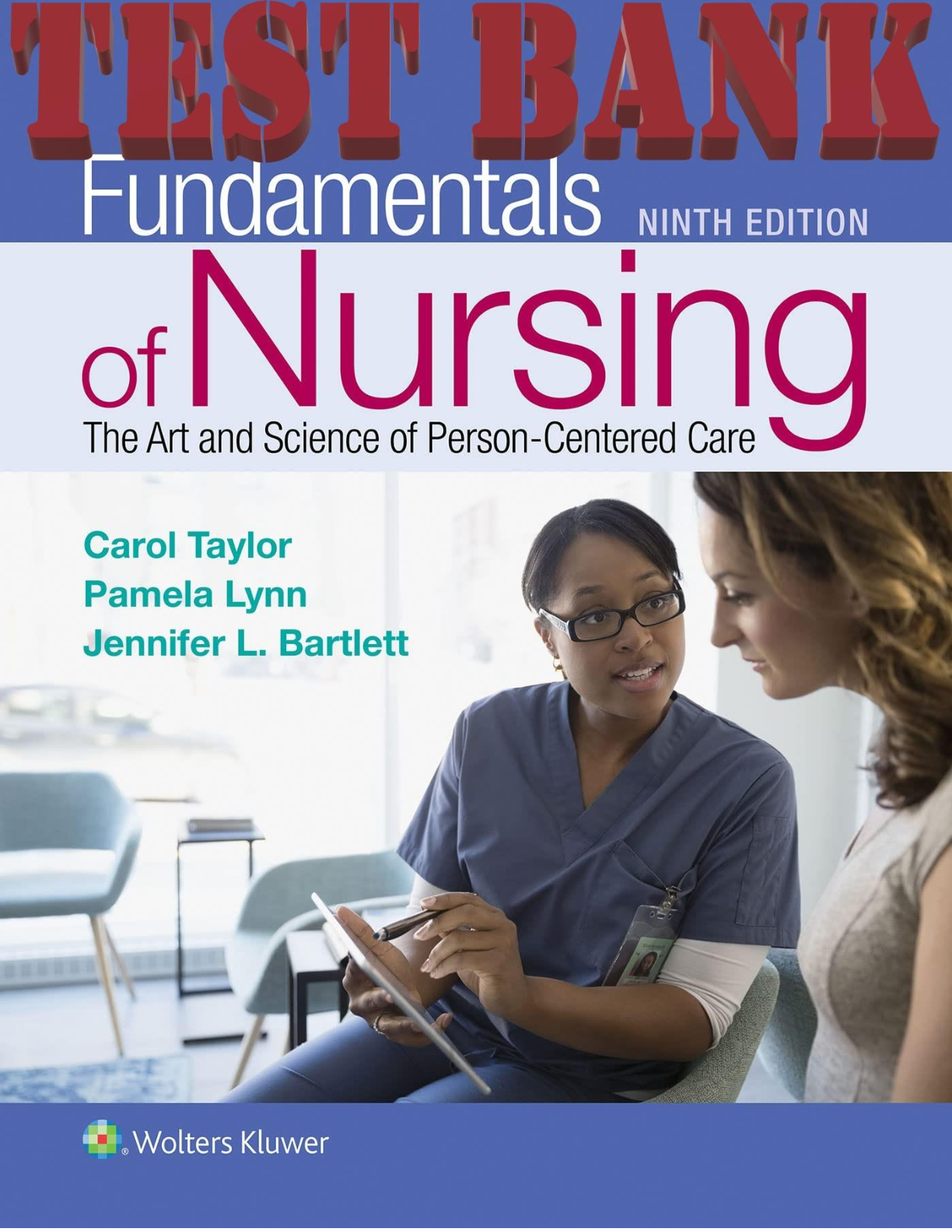
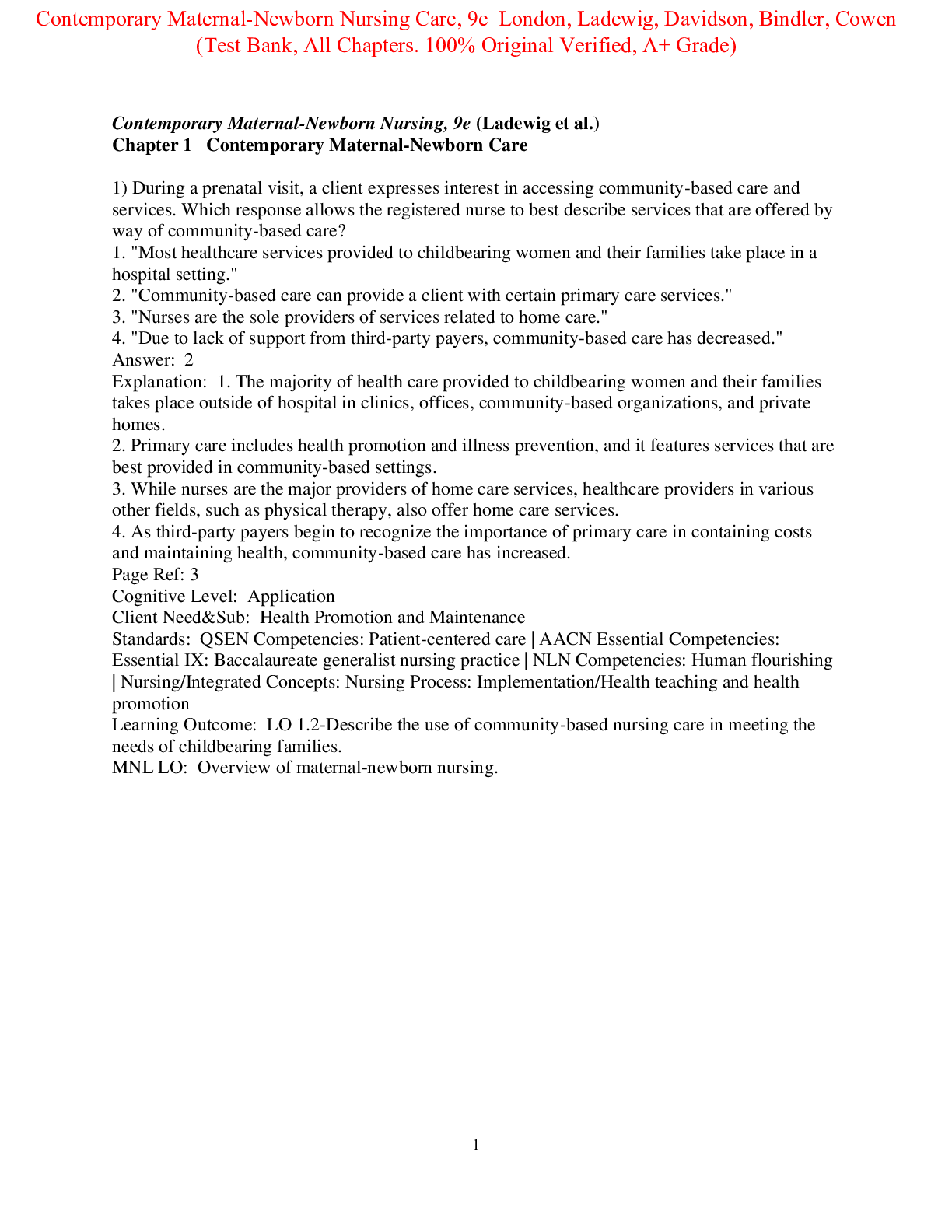
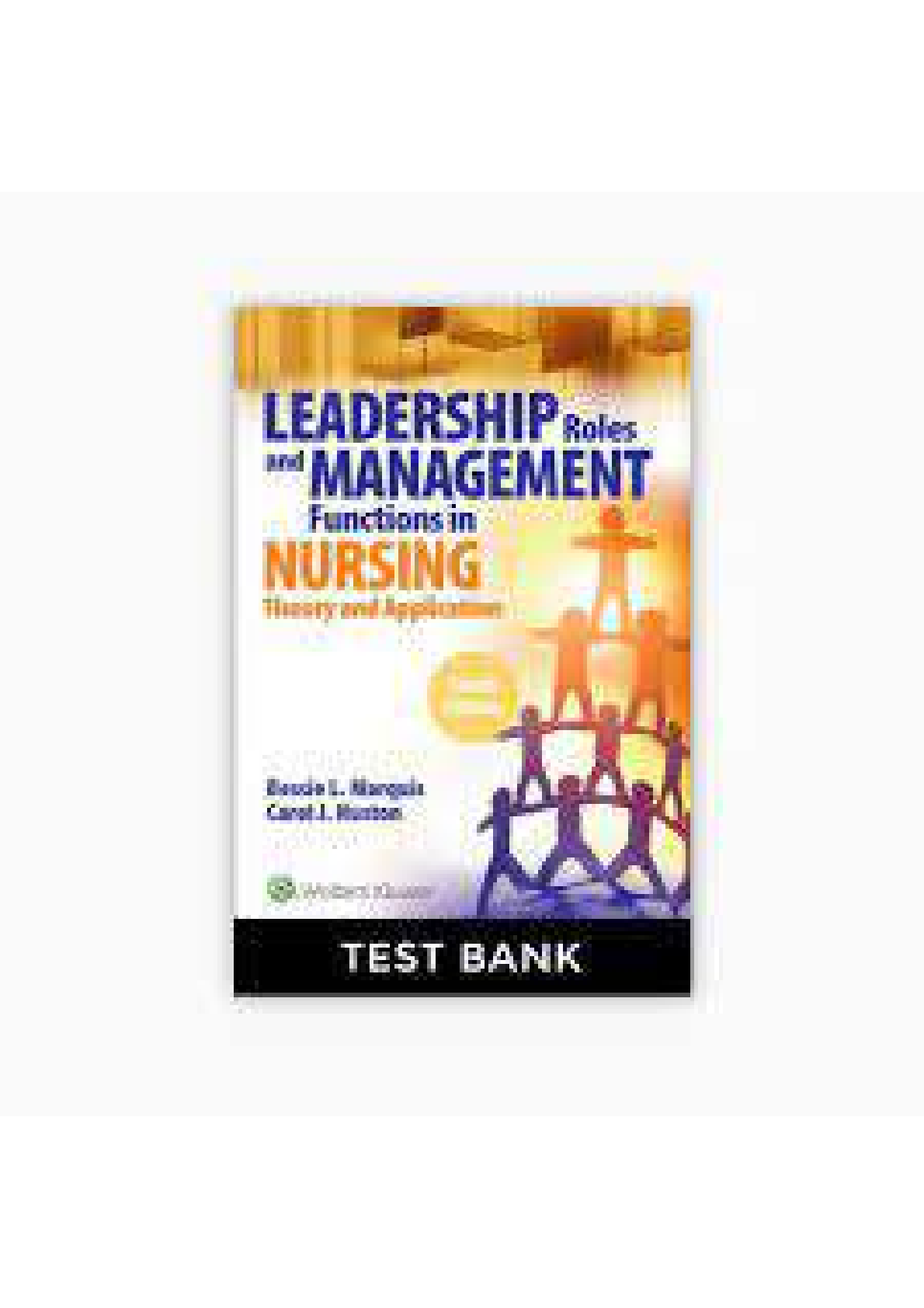
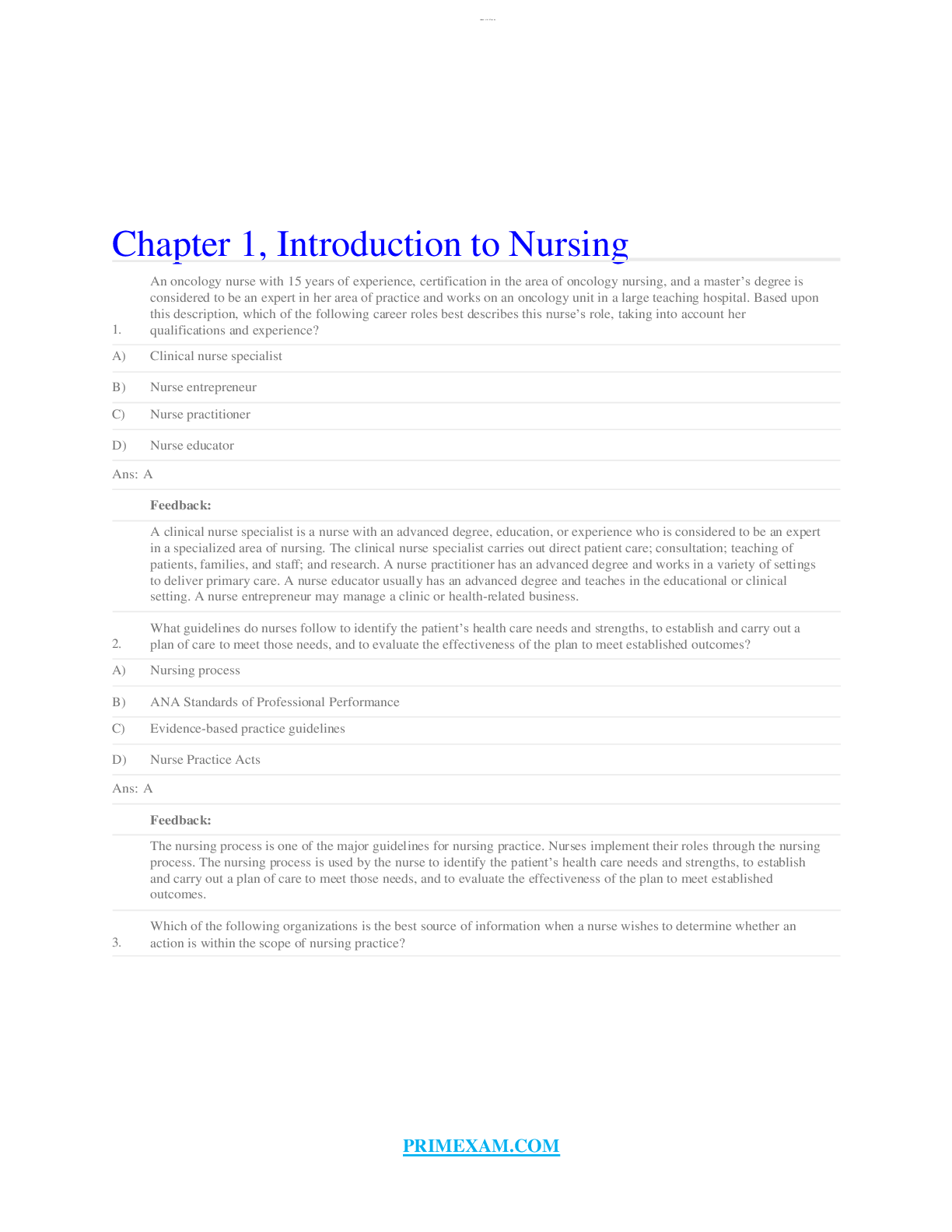
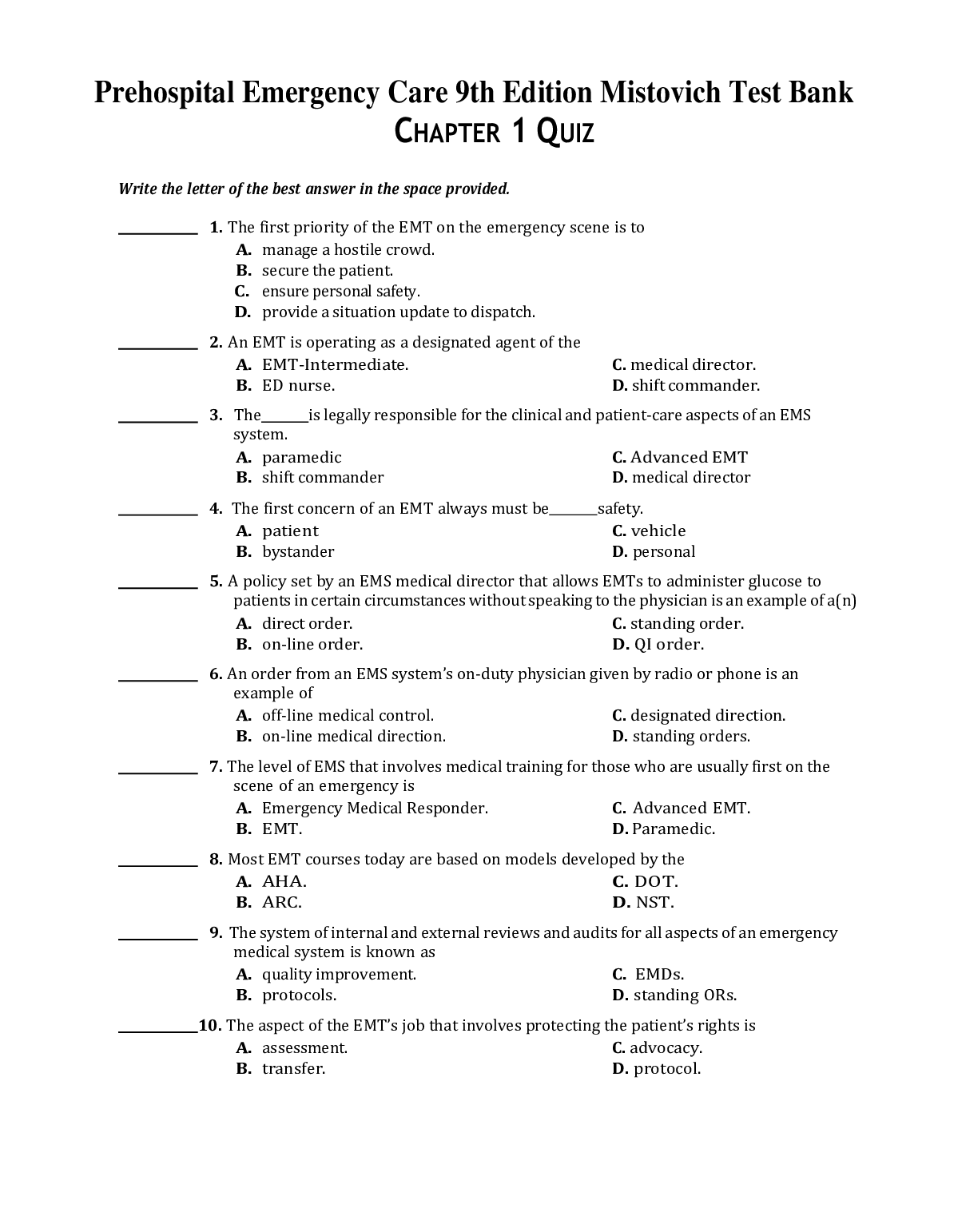
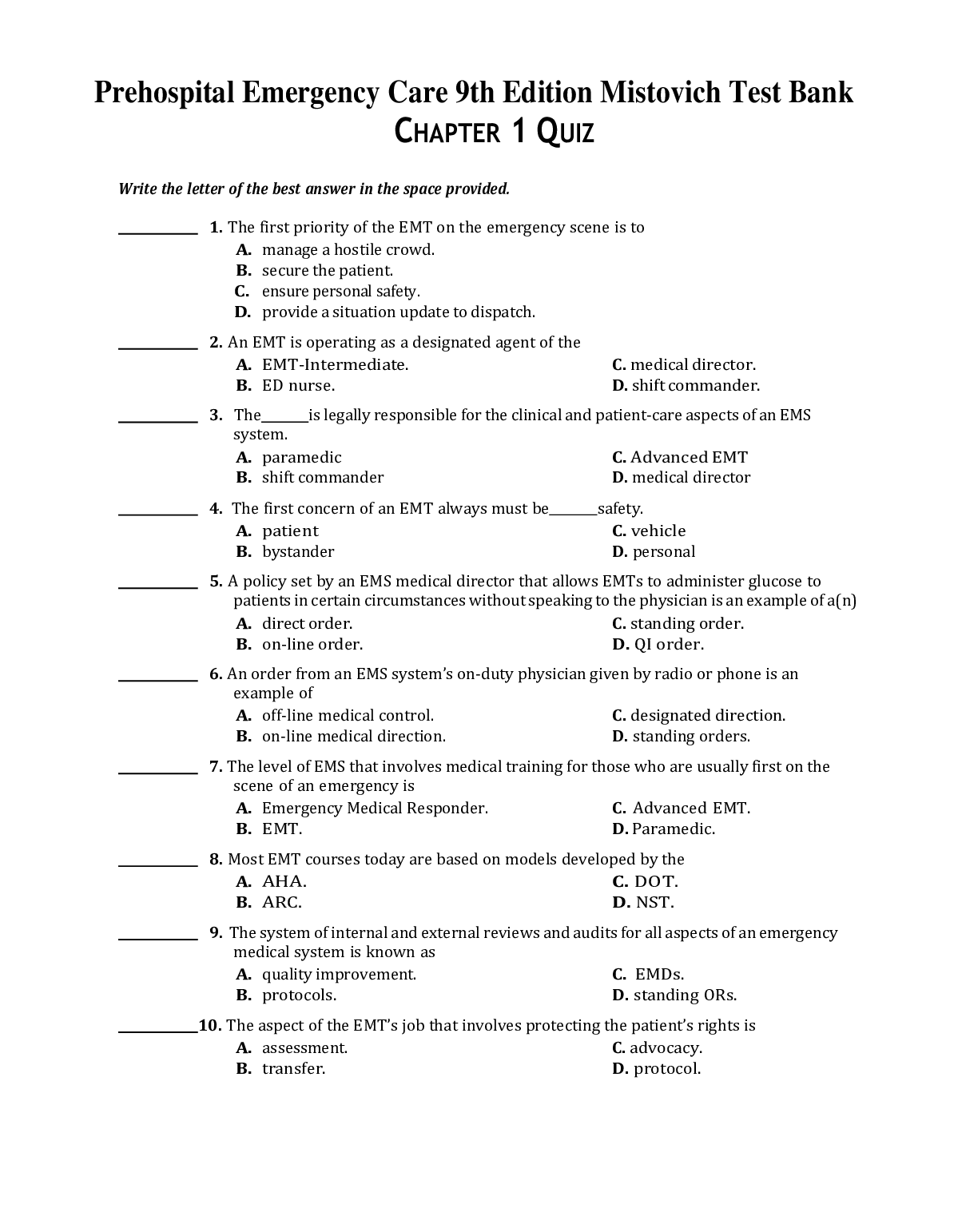

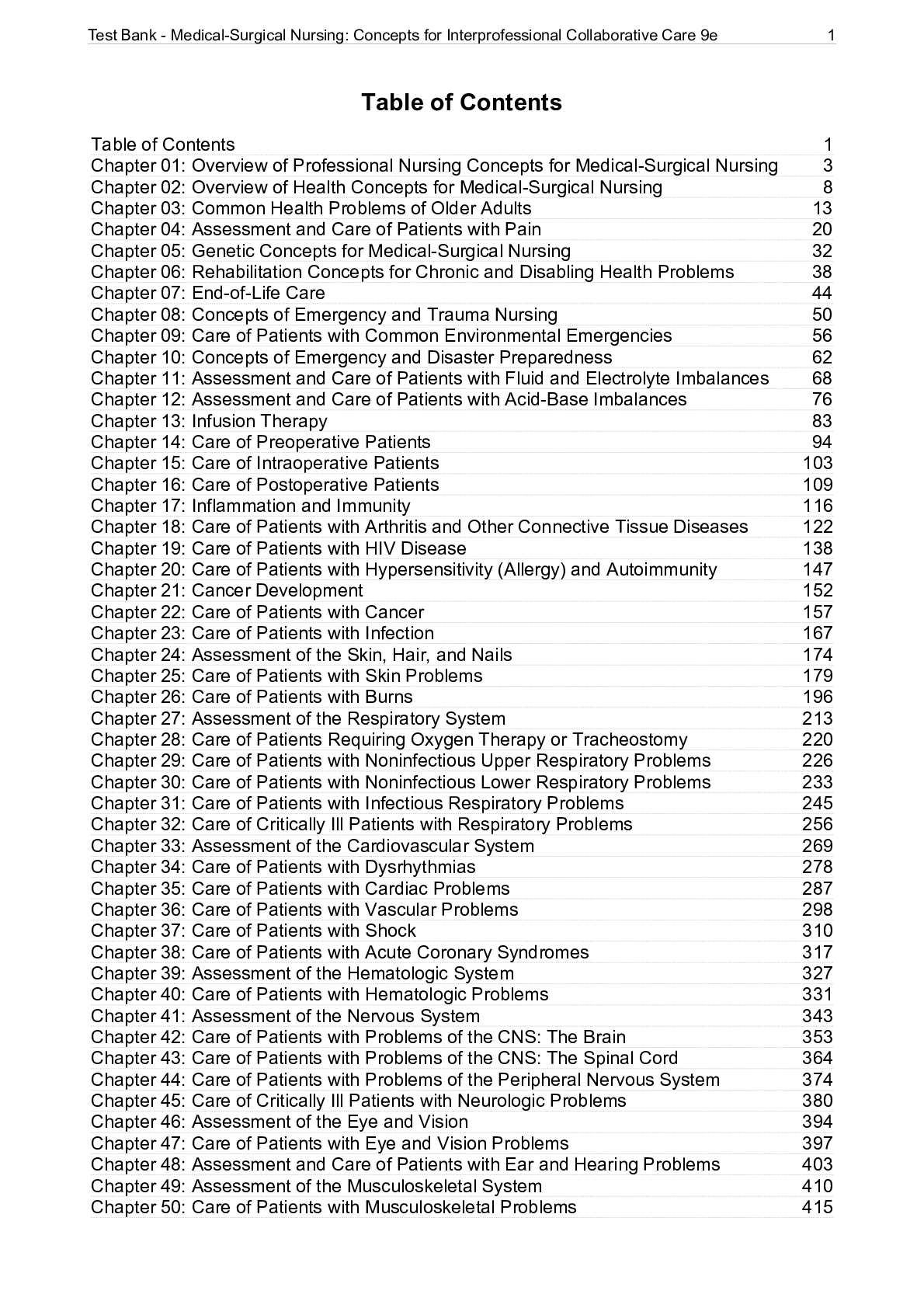

.png)
.png)
